Iran reported its first deaths from the new COVID-19 virus on February 19, 2020. It soon became one of the world’s early epicenters. The Health Ministry claimed that the disease had been spread by travelers between Iran’s holy city of Qom and China’s industrial center at Wuhan, where the coronavirus first broke out. The government initially rejected quarantines, which the Deputy Health Minister Iraj Harirchi said "belong to pre-WWI — to the plague, cholera, stuff like that."
Within a month, the coronavirus spread across Iran’s 31 provinces. By April 21, just two months after the outbreak, Iran reported 84,802 cases and 5,297 deaths. Harirchi, the deputy health minister, was one of the first senior officials to be infected. The outbreak led the government to order the mandatory quarantine of Tehran, Qom and other infected centers.
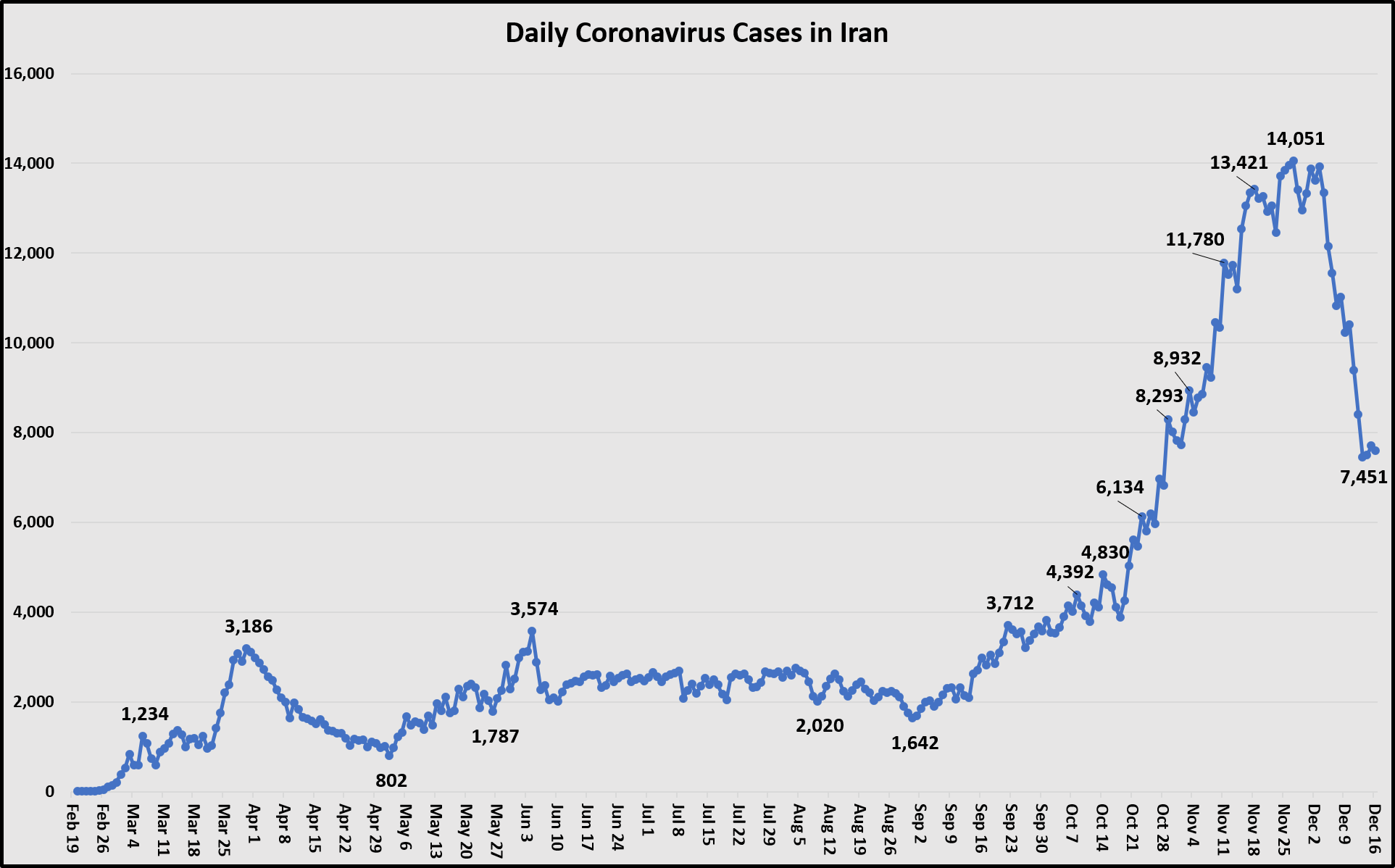
After a two-month shutdown, Iran began to slowly reopen government offices and businesses in early April. Yet the numbers of infections and deaths did not plateau over the following two months. By May 30, Iran reported a total of 146,668 cases and 7,677 fatalities in 31 provinces. Senior officials — including members of parliament, senior clerics, military commanders and government officials — were among the deaths.
Iran experienced a significant increase in COVID-19 cases in early June after the gradual reopening of businesses, mosques, schools and government offices in April and May. On June 2, Health Minister Saeed Namaki warned that Iranians had become "completely careless" with health protocols. "If we neglect the situation, we will go backwards," he said. On June 27, the Health Ministry reported that one Iranian was infected every 33 seconds and one died every 13 minutes.
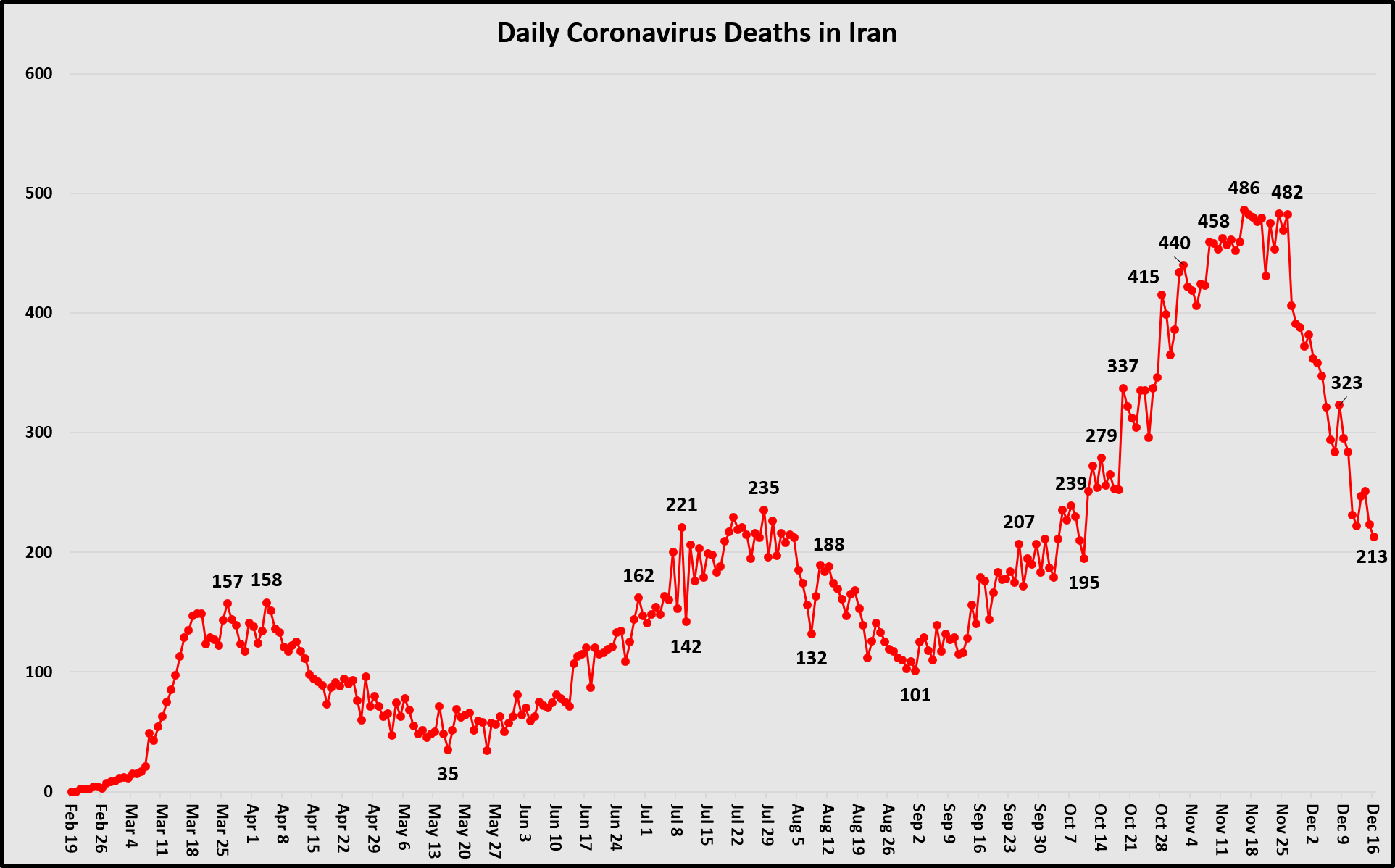
Iran made masks mandatory at all indoor gatherings from July 5 until July 22 to curb the outbreak. President Hassan Rouhani said that 25 million Iranians — about 30 percent of the population of the 84 million — may have been infected by COVID-19. On August 3, state television revealed that one Iranian was dying from COVID-19 every seven minutes.
In mid-September, Iran’s pandemic experienced a third wave, with more than 3,000 new COVID-19 cases a day. The Health Ministry declared a COVID-19 red alert for the entire country on September 18. The government threatened strict punishments of anyone who ignored health protocols. "Those who hide their disease should be fined," President Rouhani warned on October 3. Punishments for not wearing a mask included a 500,000 rial fine, year-long suspension from jobs, and closure of businesses. The Revolutionary Guards were mobilized to create field hospitals.
By the end of November, Iran recorded more than 14,000 new cases a day, a new high. The spike exceeded the two earlier peaks in March and June. More than 31,000 nurses were infected and 54 had died from the coronavirus. The government announced that Iranian scientists would cooperate with Russian companies to develop a vaccine.
By the end of 2020, Iran reported more than a million cases and more than 52,000 fatalities — a mortality rate of 4.7 percent. (The global mortality rate for the entire year was 2.2 percent; the U.S. mortality rate was 1.8 percent). The actual death toll could be three or four times the official tally, according to a senior member of Iran's medical professionals organization. In December, the government ordered lockdowns again in several major cities as it struggled to contain the spread.
Infected Officials
Dozens of high-ranking Iranian officials have contracted COVID-19, which originated in China in late 2019 and was first reported in the Islamic Republic in February. Two vice presidents were among the early cases. The virus has since swept through the ranks of the executive branch, parliament, the military, the clergy and even the health care services.
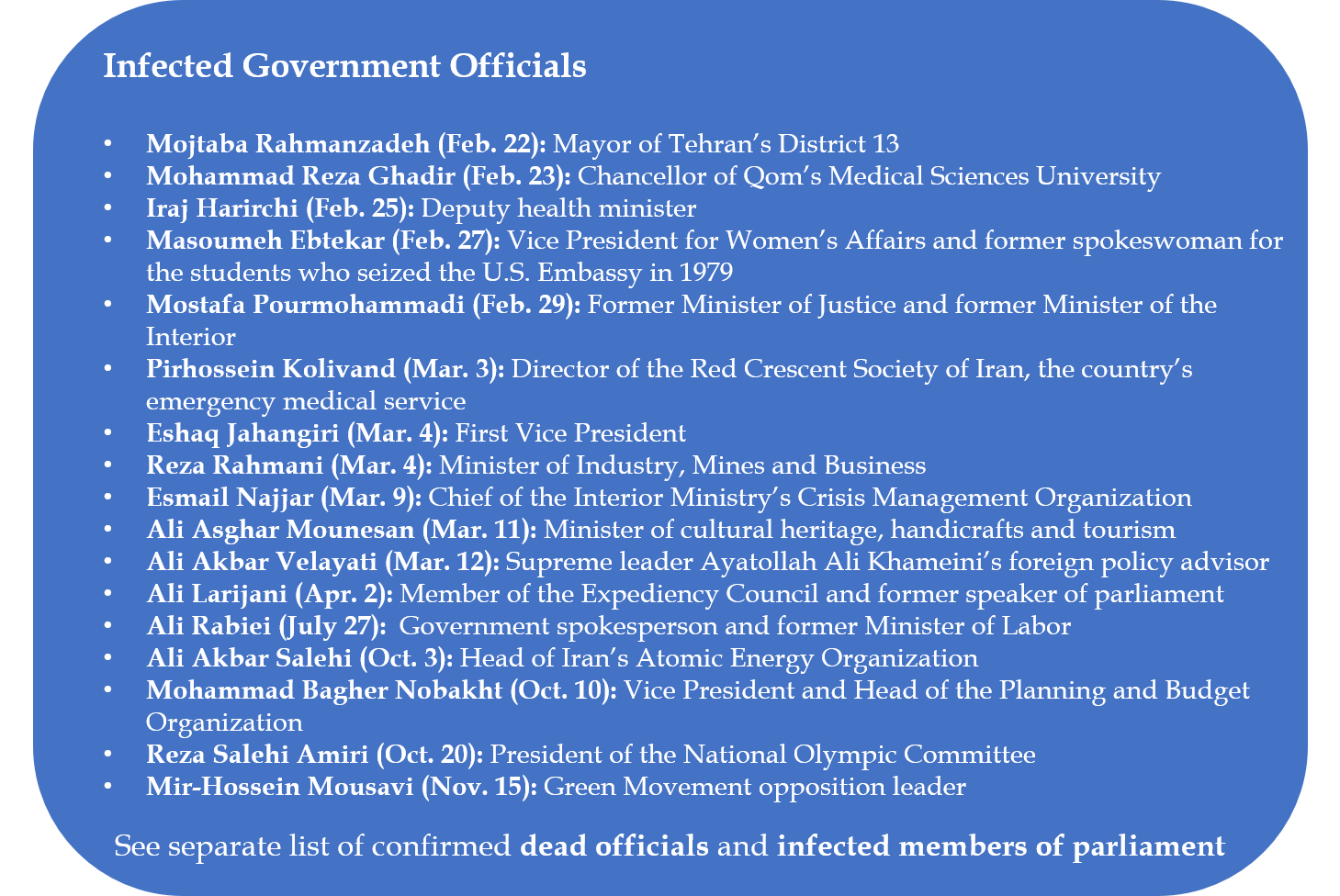
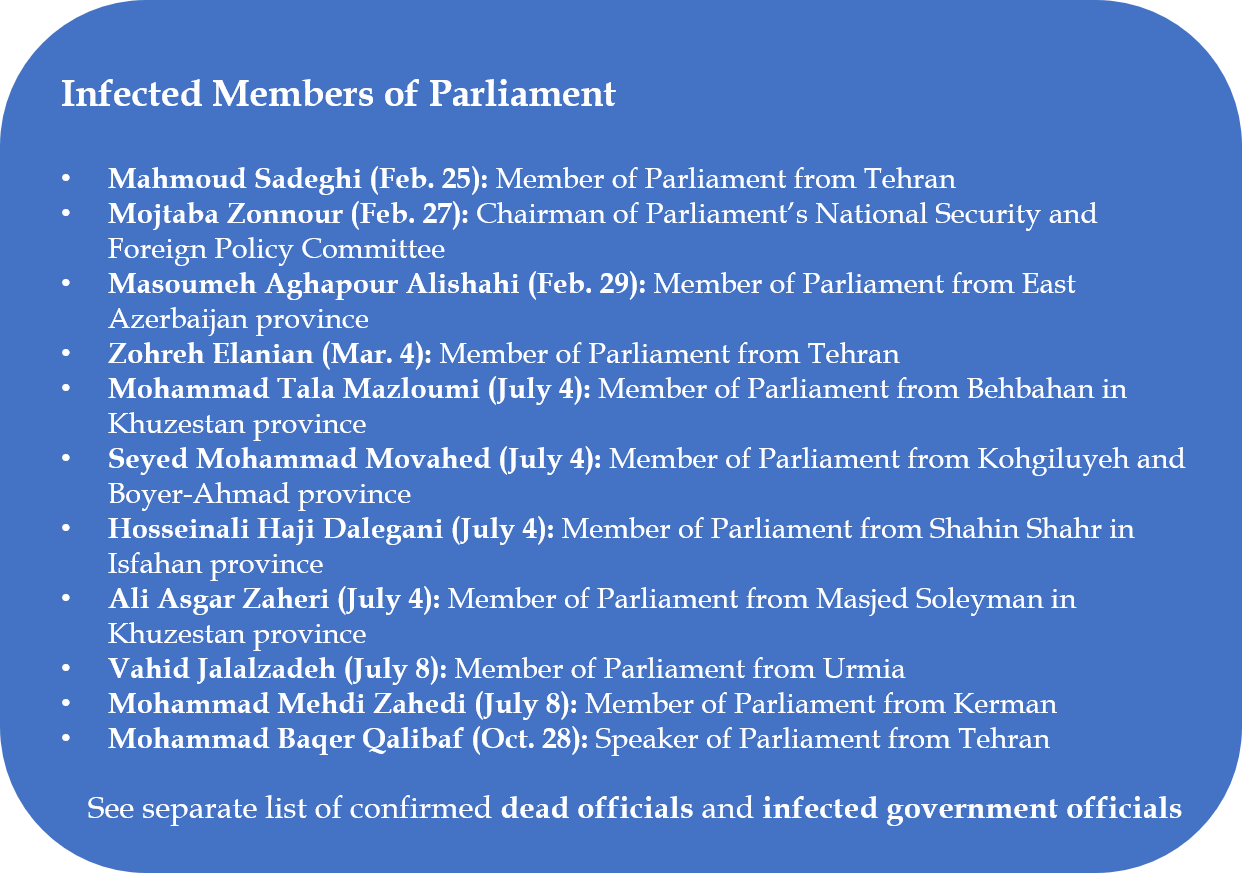
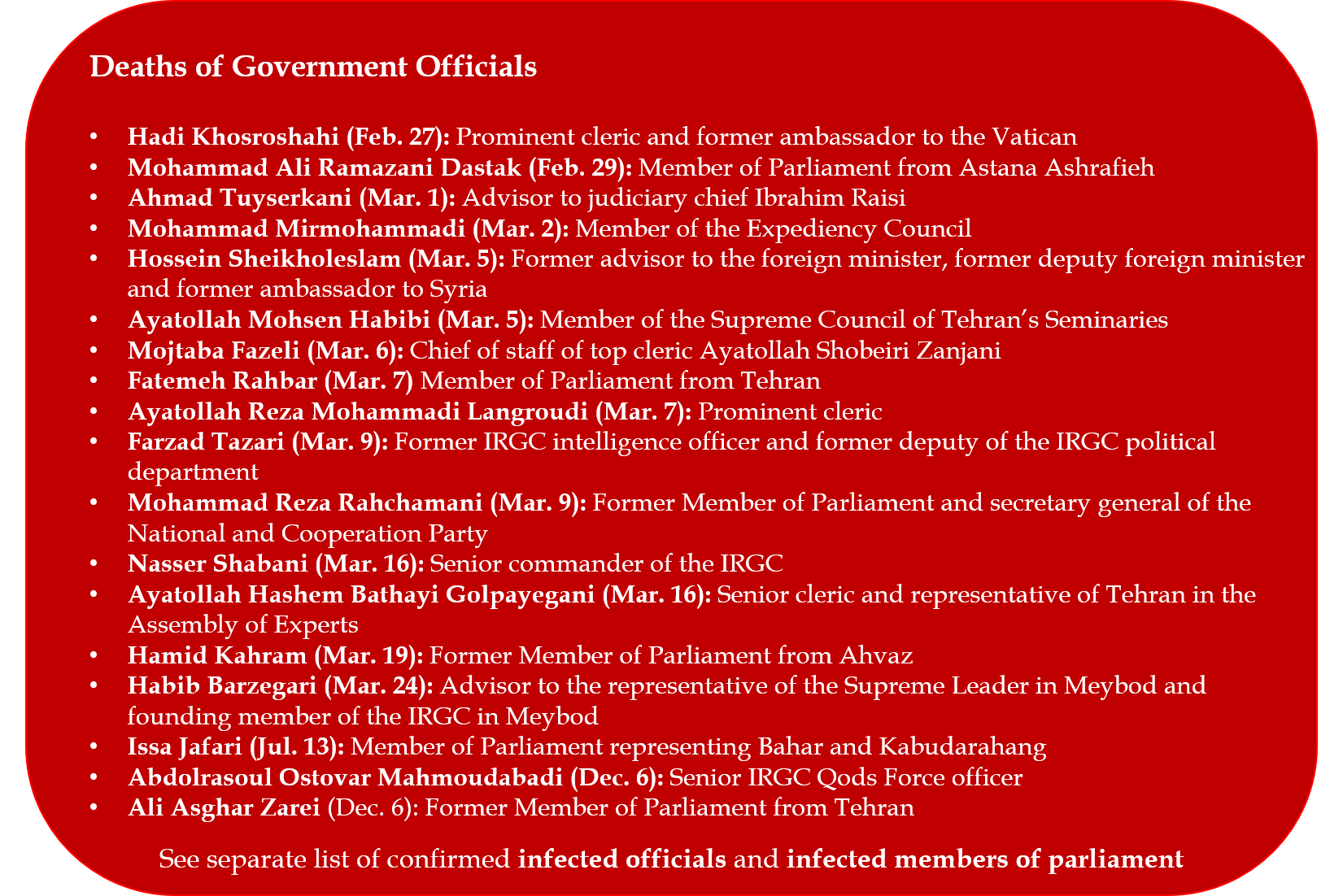
Timeline of COVID-19 in 2020
Week 1: February 16 – February 22
On February 19, Iran recorded its first case of the novel coronavirus.
Week 2: February 23 – February 29
On February 23, four of Iran's neighbors — Turkey, Pakistan, Afghanistan and Armenia — said that they would close their land borders. Afghanistan and Armenia suspended all air traffic, while Turkey halted arrival flights from Iran.
On February 24, President Rouhani assured the country that officials had “mobilized all of our resources” to contain the disease “in the shortest time with the minimum casualties.” Officials warned against overreacting to the outbreak, which they claimed was stabilized and under control. "We have managed to reduce the problem to the minimum," said Deputy Health Minister Harirchi.
Harirchi said that the government was against quarantines of Iranian cities, which he claimed could cause more harm than good. "With regard to quarantines – we are absolutely against them. Quarantines belong to pre-WWI – to the Plague, cholera, stuff like that," he said. "The Chinese themselves are not so pleased with the quarantine there. After all, quarantines have consequences. Let's suppose that you quarantine a certain city – what would the people of that city do? Look, we are carefully calculating all our decisions. We are analyzing and forecasting the effects of each decision we make. Let's assume that we shut down Qom for ten consecutive days. Everybody would go traveling, and this will cause the disease to spread all over the country."
But on the same day, Ahmad Amiriabadi Farahani, a lawmaker from Qom, accused the regime of covering up the true number of deaths and charged that the government had not done enough to stem infections. He reported that 50 people had died from the coronavirus in Qom. “So far, I have not seen any particular action to confront corona by the administration,” Farahani said.
On February 24, Harirchi refuted Farahani's claim during a press conference in which he appeared visibly sick, sweating profusely and using tissues to wipe his brow. "If it is confirmed that even half of this number is true, I will resign," Harirchi declared. A day later, the government reported that Harirchi had contracted the virus.
More than two dozen other officials also contracted the disease. Iranian health officials claimed that longstanding U.S. sanctions and the recent Financial Action Task Force’s decision to blacklist Iran had hindered the delivery of diagnostic test kits. “Multiple international companies are ready to supply Iran with corona (virus) test kits but we can’t send the money to them,” Ramin Fallah, vice president of the Iranian Union of Importers of Medical Equipment, said on February 24. Tedros Adhanom Ghebreyesus, director-general of the World Health Organization, called the sudden outbreak in Iran “very worrisome. We have to engage them even more.”
More than two dozen other officials also contracted the disease. Iranian health officials claimed that longstanding U.S. sanctions and the recent Financial Action Task Force’s decision to blacklist Iran had hindered the delivery of diagnostic test kits. “Multiple international companies are ready to supply Iran with corona (virus) test kits but we can’t send the money to them,” Ramin Fallah, vice president of the Iranian Union of Importers of Medical Equipment, said on February 24. Tedros Adhanom Ghebreyesus, director-general of the World Health Organization, called the sudden outbreak in Iran “very worrisome. We have to engage them even more.”
On February 25, U.S. Secretary of State Mike Pompeo accused Iran of covering up the extent of the outbreak. “The United States is deeply concerned by information indicating the Iranian regime may have suppressed vital details about the outbreak in that country,” Pompeo told reporters. “All nations, including Iran, should tell the truth about the coronavirus and cooperate with international aid organizations."
President Rouhani said that the virus was being used by Iran's adversaries to cause panic in the country. "In schools, high schools, universities and work places, everybody should pay attention to health recommendations, but we must all continue our work and activities, because it is one of the enemies' plots to spread fear in our country and close down the country," Rouhani said.
Afghanistan reopened its land borders with Iran after being closed for two days.
On February 26, President Rouhani urged the public not to let the virus become a "weapon" of the United States. "We must not let the United States attach a new virus to the coronavirus by stopping our social activities through tremendous fear; this is a conspiracy we see today and you see in foreign propaganda," he said.
Week 3: March 1 – 7
On March 2, France, Germany and Britain provided the Iranian government with nearly $5.6 million to help fight the country's coronavirus outbreak. The countries also pledged to deliver medical equipment through the World Health Organization and other U.N. agencies. "France, Germany and the United Kingdom express their full solidarity with all impacted by COVID-19 in Iran," the countries said in a joint statement. "We are offering Iran a comprehensive package of both material and financial support to combat the rapid spread of the disease."
On March 4, President Rouhani said that the coronavirus had spread to nearly every province. He criticized U.S. offers of provide humanitarian aid. “They [the United States] have appeared with a mask of sympathy that ‘we also want to help the people of Iran," he said. “If you are really telling the truth, then lift sanctions from medicine.” To document the number of coronavirus deaths, an Iranian secretly took video of bodies at a cemetery morgue. IranWire reported that he was subsequently arrested for recording without a permit.
Week 4: March 8 – 14
On March 8, four lawmakers called on the Supreme National Security Council to order a “mandatory quarantine of Tehran, Qom and other infected centers.” They also urged wealthy religious foundations to distribute medical supplies.
Iraq closed its land borders with Iran until March 15.
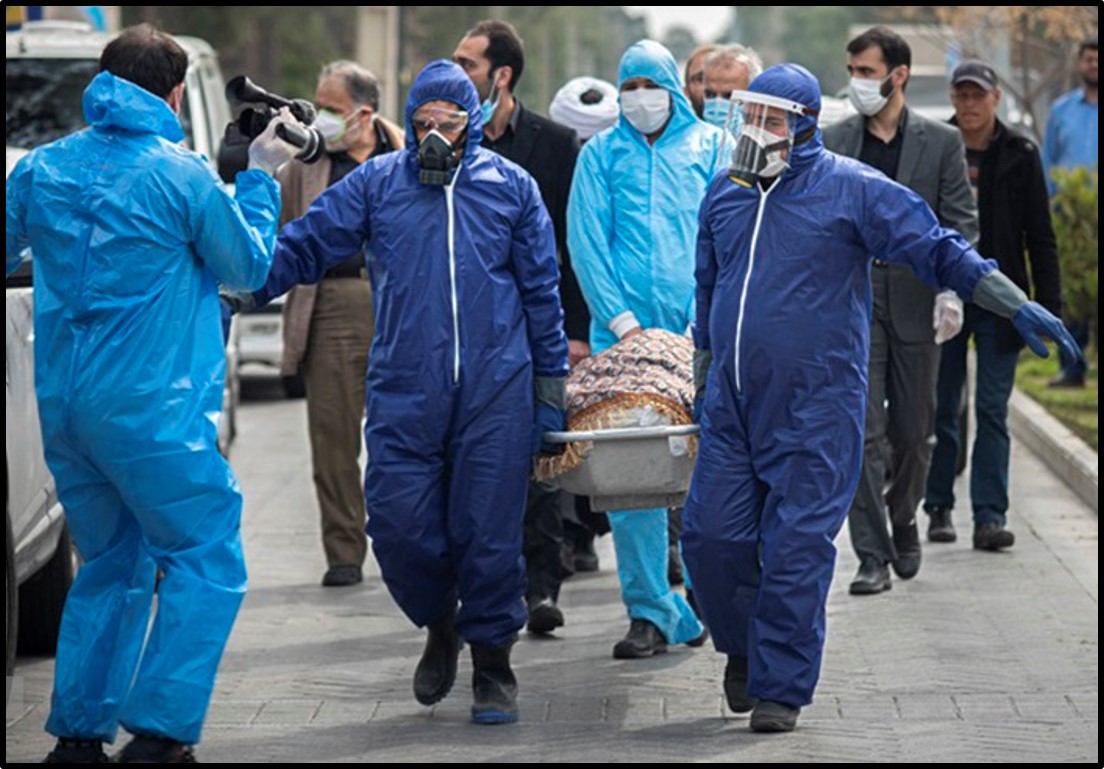
On March 9, a lawmaker from Kashan, which is situated between two areas with high concentrations of cases – Qom and Isfahan – asked the Health Ministry to order offices in in Kashan closed. Javad Sadati Nejad noted that the city’s two hospitals were already short on medical supplies. He made a personal request for residents to avoid leaving their homes.
On March 9, the supreme leader’s office announced that Ayatollah Khamenei would not travel to the holy city of Mashhad to give his Nowruz (Persian New Year) address. The statement cited warnings from public health experts to limit travel. In his annual speech, Khamenei discussed pressing challenges to the country, accomplishments from the previous year and his vision for the next year.
On March 11, Iran reported that five members of the IRGC had died from coronavirus.
On March 12, Iran asked the International Monetary Fund (IMF) for a $5 billion emergency loan to help fight the country's coronavirus outbreak. The IMF “has stated that countries affected by #COVID19 (coronavirus) will be supported via Rapid Financial Instrument. Our Central Bank requested access to this facility immediately,” Foreign Minister Zarif said in a tweet. Iranian Central Bank chief Abdolnaser Hemmati wrote IMF managing director Kristalina Georgieva to request financial aid.
In a separate letter to U.N. Secretary General Antonio Guterres, Foreign Minister Zarif urged the United Nations to demand that the United States lift sanctions on Iran. He said that the U.S. “maximum pressure” campaign was hampering Iran’s ability to cope with the COVID-19 coronavirus. “Although our medical facilities, doctors, nurses and other health practitioners are among the very finest in the world, we are stymied in our efforts to identify and treat our patients; in combatting the spread of the virus; and, ultimately, in defeating it, by the campaign of economic terrorism perpetrated by the Government of the United States,” Zarif wrote.
Week 5: March 15 – March 21
On March 15, the U.S. State Department Persian-language account tweeted a link to an anonymous survey via Telegram, an encrypted social media app, to encourage Iranians to provide information about the country's coronavirus outbreak. Within three days, the account received some 7,000 responses to the 37-question survey. An unnamed State Department official said that the tips were mainly about "particular facilities that people have seen coronavirus victims, particular regions, particular misstatements by the officials." The State Department intended to use the data to determine if Iran was under-reporting cases. "The picture painted is one of intimidation and mass falsifications of statistics," the State Department official said. "We are getting the unfiltered facts."
Iraq indefinitely extended the closure of its land border with Iran.
On March 17, President Rouhani unveiled a stamp commemorating the medical professionals fighting Iran's coronavirus outbreak. The stamp was inscribed with the words "National Heroes."
On March 18, Foreign Minister Zarif slammed U.S. sanctions, which he called "economic terrorism," in his annual Nowruz speech. He accused the U.S. government of inhibiting Iran's ability to contain the coronavirus outbreak. “When a nation’s right to access to medicine, food and other humanitarian items is violated, it will be placed on an unequal and more vulnerable position in comparison with the other countries," he said. "The U.S. is trying to ultimately turn our country into an isolated island in an ocean of threats and miseries through the constant increase in the layers and depth of the sanctions."
On March 19, five former health ministers urged the regime to take "fundamental steps" to stem the spread of coronavirus in Iran. In a letter to President Rouhani, the former officials, who are also medical doctors, called on the government to take immediate measures, including "limiting movement of people, holiday trips, shutting non-essential businesses and big shopping centers." The doctors said that all non-essential activities should be halted for at least two weeks. "The trend of the disease and its consequences continue to show an upward trajectory and it has not declined in any part of the country," they warned.
On March 20, IranWire published evidence of Iran’s delay in responding to early signs of the coronavirus. The report cited guidelines issued on February 19 by Iran’s Civil Defense Organization, which revealed that the government ordered a three-day delay in implementing measures to stem the country's coronavirus outbreak. Subsequent reporting claimed that the government wanted to ensure a large turnout in parliamentary elections on February 21. Separately, Gholamreza Jalali, commander of the Civil Defense Organization, sent a letter, dated January 31, to the armed forces’ chief of staff, the secretary of the Supreme National Security Council and the interior minister in which he acknowledged a COVID-19 outbreak in Qom. The government did not report cases to the public until February 19.
Week 6: March 22 – March 28
On March 22, Supreme Leader Ayatollah Khamenei called U.S. leaders "charlatans and liars" and rejected the U.S. offer to provide humanitarian aid to Iran. “Several times Americans have offered to help us to fight the pandemic. That is strange because you face shortages in America. Also you are accused of creating this virus,” Khamenei said. “I do not know whether it is true. But when there is such an allegation, can a wise man trust you and accept your help offer? ... You could be giving medicines to Iran that spread the virus or cause it to remain permanently.”
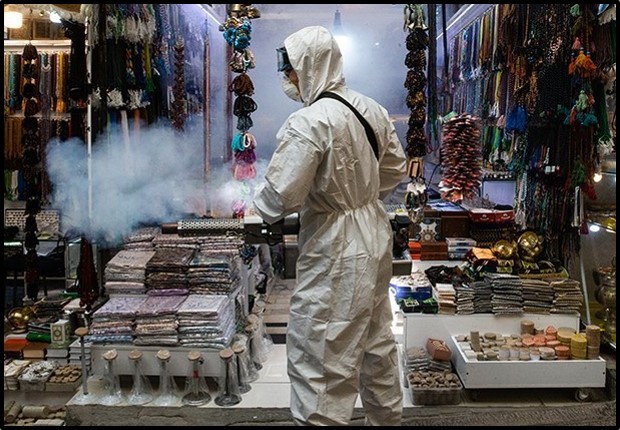
President Rouhani said that Iran would not accept U.S. humanitarian aid and called on the United States to lift sanctions to help fight the virus. “American leaders are lying ... If they want to help Iran, all they need to do is to lift sanctions .... Then we can deal with the coronavirus outbreak,” Rouhani said.
Hamidreza Goudarzi, the deputy governor of Tehran Province, ordered all businesses except for gas stations, pharmacies, supermarkets and bakeries to close indefinitely.
On March 23, the U.N. High Commission for Refugees delivered 4.4 tons of medical supplies to Iran. The shipment included masks, gloves and essential medicines. The U.N. agency said that additional humanitarian aid deliveries were scheduled "in the coming weeks."
On March 24, President Rouhani announced that Iran would extend furloughs, from April 3 to April 19, that had been granted to 85,000 prisoners because of the pandemic. Tehran rejected humanitarian aid, including a 50-bed inflatable hospital and a 9-person emergency team, from Medecins Sans Frontieres (MSF) or Doctors Without Borders. “The Iranian Armed Forces' medical capabilities are entirely at its service, Iran did not need hospitals established by foreigners. The MSF presence in Iran is irrelevant,” said Ministry of Health advisor Alireza Vahhabzadeh. MSF said that the organization was "deeply surprised" to hear that the aid had been rejected. "The need for this intervention, and the authorizations needed to start it, were discussed and agreed with relevant Iranian authorities during the past weeks. Our teams were ready to start medical activities at the end of this week," said Michel Olivier Lacharité, manager of the MSF Emergency programs in Paris.
On March 25, President Rouhani said that Iran planned to implement a travel ban for the remainder of the two-week Nowruz holiday. "This plan is strict and it will create difficulties and restrictions for travel and prompt people who have already traveled to return home faster," he said. Rouhani added that all parks would be closed and Sizdah Bedar, an annual nature festival on April 1, "will not be like previous years."
Government spokesman Ali Rabiei warned that Iran could face a second wave of coronavirus cases if Iranians did not follow government orders. "Unfortunately some Iranians ignored advice from health ministry officials and travelled during the (Iranian) New Year holidays ... This could cause a second wave of the coronavirus," Rabiei said.
Iran announced that it would accept humanitarian aid from Medecins Sans Frontieres, a day after rejecting help from the international medical charity. "We thank Doctors Without Borders for their help. Their donated equipment will be used by the Ministry of Health in the areas where it is required," government spokesman Ali Rabiei said.
On March 28, President Rouhani said that Iran would allocate 20 percent of its new annual budget, or $6.3 billion (at free market values) to combat the COVID-19 outbreak. The allocation would include grants and low-interest loans to offset the impact of the virus.
Week 7: March 29 – April 4
On March 29, Deputy Health Minister Harirchi said that Tehran could not rule out the possibility that COVID-19 was a biological weapon deployed by the United States. He said that the Ministry of Health was conducting "serious investigations" into the matter. “If they just remove the barriers, we can provide the resources we need with oil and non-oil exports," he said.
President Rouhani urged citizens to continue with "the new way of life" in Iran, which he said could last for an extended period of time. "We must prepare to live with the virus until a treatment is discovered. The new measures that have been imposed are for everyone’s benefit. Our main priority is the safety and the health of our people," Rouhani said. He also appealed for national unity to fight the outbreak. "Another point I would like to say is that now is not the time for gathering teams and waging a political war; it is not about political war, nor party, nor ethnicity, nor national; but it is a public global issue," he said.
Foreign Minister Zarif accused the United States of waging an "economic war" on Iran. In a tweet, he said that sanctions amounted to war crimes.
On March 30, State Department Spokesperson Morgan Ortagus said that Iran's regime, not sanctions, were the problem. In a tweet, she claimed that the supreme leader had access to a "tax-free hedge fund" worth billions of dollars. The U.S. government had previously accused Khamenei of profiting from an "off-the-books" hedge fund, allegedly valued at $95 billion, called the Setad.
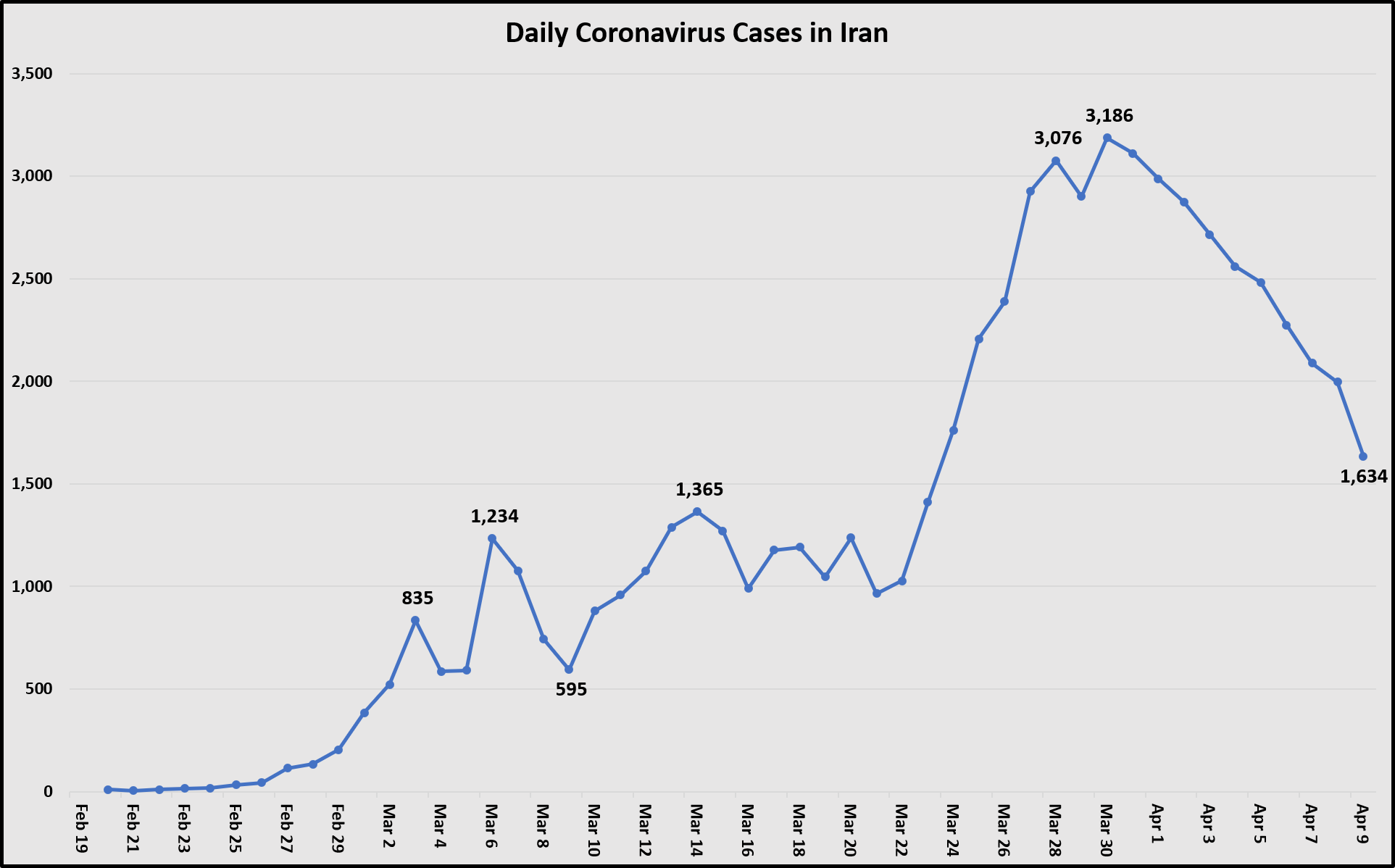
On April 1, President Rouhani said that Iran was successfully containing the outbreak. “Fortunately, the statistics I read last night from all the provinces shows a downward trend in all provinces,” he said at a cabinet meeting. Rouhani claimed that Iran’s increasingly strict travel restrictions and social distancing would curb infections without having to enforce the kind of lockdown used in Wuhan, China. His optimistic tone starkly contrasted with media reports that Iran’s healthcare system was severely overstretched.
On April 4, Deputy Health Minister Harirchi warned that Tehran could see a surge in coronavirus cases if citizens did not follow government guidelines. "We are still concerned about the virus, for example with the level of traffic in Tehran today and queues of cars stuck on freeways, because these people can take the virus to their homes or workplaces," he said.
Week 8: April 5 – 11
On April 5, the government announced that low-risk economic activities would resume on April 11. President Rouhani added that high-risk activities, including classes at schools and universities and social, cultural, sports and religious events would be suspended until at least April 18.
On April 7, more than two-thirds of parliament’s 290 lawmakers gathered for the first time since February 25. They rejected an emergency bill requiring a one-month nationwide lockdown to stem further cases of the virus. 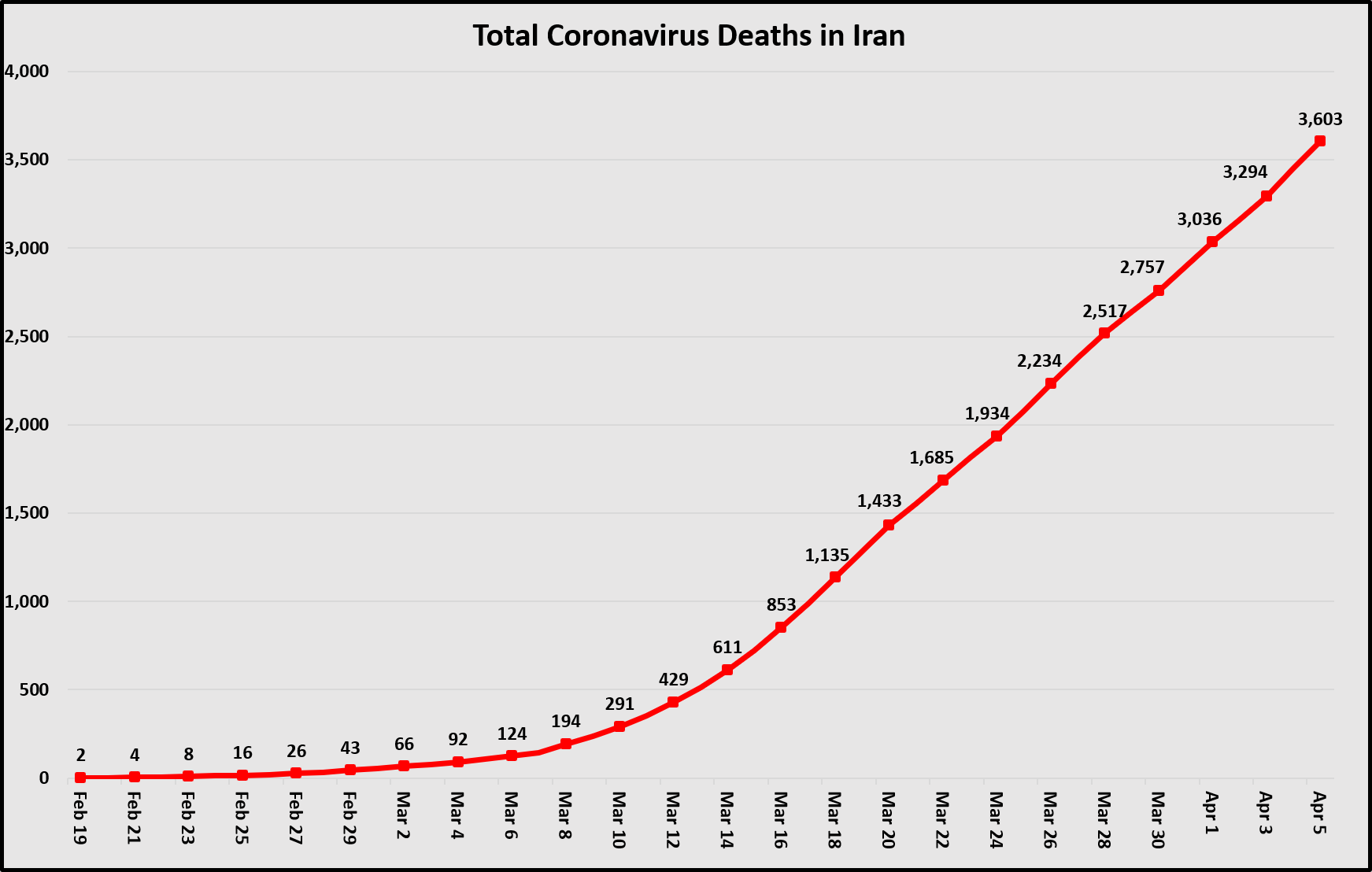
On April 9, Supreme Leader Ayatollah Ali Khamenei announced that mass gatherings during the holy month of Ramadan, beginning at the end of April, would be banned. “In the absence of these meetings, remember to heed your prayers and devotions in your lonesomeness,” he said.
On April 11, government offices in Tehran resumed operations with two-thirds of staff allowed to return. Low-risk businesses outside of Tehran , including shops, factories and workshops, were allowed to reopen. The government said that high-risk businesses — such as theaters, swimming pools, saunas, beauty salons, schools, shopping centers, and restaurants — would remain closed indefinitely.
Week 9: April 12 – April 18
On April 12, the government lifted restrictions on travel between cities within the same province. State media reported that travel between different provinces will be allowed beginning on April 20.
President Rouhani claimed that Iran handled the coronavirus outbreak better than Europe and the United States, despite the added burden of economic sanctions. "We had a sanctions virus, to which the coronavirus was added, but you [Europe and the United States] did not have the sanctions virus. You have one virus while we have two viruses," he said.
On April 14, Iran’s parliamentary think tank suggested that the infections and deaths from the COVID-19 virus could be nearly double the official count due to underestimates and poor testing. The 46-page report said that the Health Ministry only counted patients who had died in hospitals and tested positive for the virus. People who died in their homes were not included in the count, according to health experts.
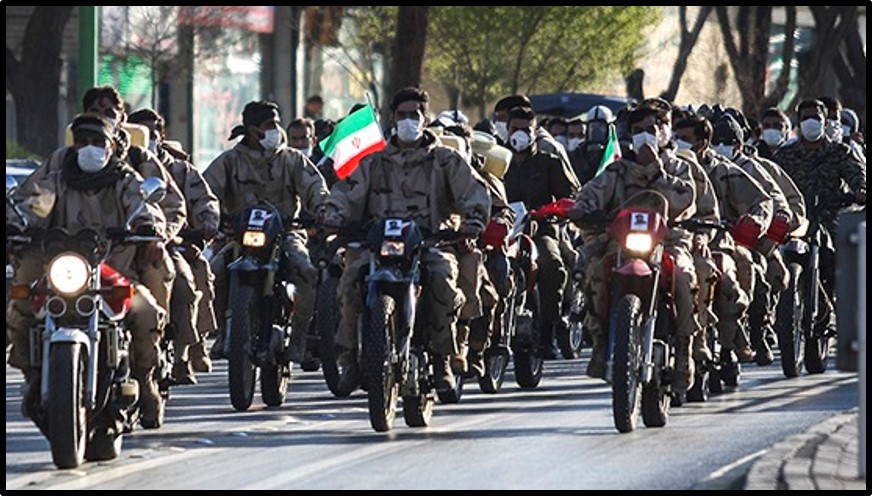
On April 17, Iran held a parade on National Army Day with a decidedly different focus. It featured disinfection vehicles, mobile hospitals and other medical equipment instead of the usual missiles, soldiers and warplanes. The “Defenders of the Homeland, Helpers of Health” parade, hosted at a training facility in front of senior commanders, highlighted the role that the military had played in combating the country's COVID-19 outbreak. President Rouhani said, “Due to health and social protocols, it is not possible to hold a parade of soldiers...The enemy now is hidden and doctors and nurses are (instead) at the frontlines of the battlefield.”
On April 18, crowds flocked to businesses as some shops, factories and workshops reopened in Tehran. The Grand Bazaar, covered markets and shopping malls remained closed. Traffic in Tehran was 70 percent higher compared to the same day the year before, according to Tehran's traffic police chief. "The consequences of today’s congestion will reveal themselves to medical centers five to 14 days from now," said Alireza Zali, head of Iran's coronavirus task force.
Week 10: April 19 – 25
On April 19, President Rouhani announced that mosques and holy sites would remain closed until at least May 4. "Decisions on gatherings during the (Muslim holy month of) Ramadan will be taken next week," Rouhani added.
On April 20, shopping malls and bazaars reopened in Tehran despite warnings from health officials. The Ministry of Health said that inspectors would be dispatched to ensure businesses were complying with government guidelines. “Everything depends on the degree to which people are respecting the health protocols. People should not think that the situation has become normal again,” said Mohammad Asayi, an adviser to the health minister.
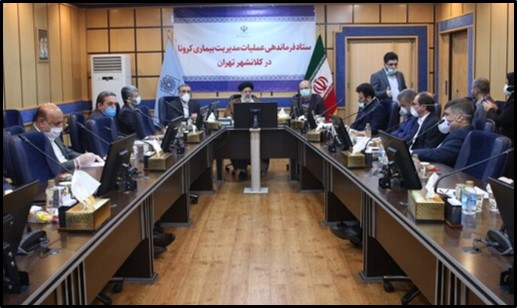
On April 22, Iran reopened public parks and recreational areas. The daily death toll had fallen below 100 for eight consecutive days.
On April 25, President Rouhani said that the country must prepare for the "worst-case" scenario — that disruptions from coronavirus could last until March 2021. “Our first request is that we should plan production long-term based on a pessimistic view that we might face this virus ... for months,” Rouhani said. "Maybe (we will face this) till the end of the year, we do not know."
Alireza Zali, Tehran's coronavirus coordinator, warned that a "hasty" lifting of restrictions could "create new waves of sickness in Tehran and complicate efforts to bring the epidemic under control."
On April 25, Pakistan reopened the Rimdan border crossing with Iran. At least 14 Iranian trucks carrying exports were allowed to cross into Pakistan the same day. The border had been closed since March 15 to stem the spread of the virus.
Week 11: April 26 – May 2
On April 26, President Rouhani announced that Iran would gradually begin to reopen religious sites in certain areas. Regions would be divided into white, yellow and red zones based on the number of COVID-19 infections and deaths. Counties that had been consistently free of infections or deaths would be labeled white, and mosques would be allowed to reopen. Deputy Health Minister Harirchi said that 116 counties had been designated as white and 134 as yellow.
On April 28, President Rouhani told Iranians to be cautious but not afraid of COVID-19. “Excessive fear, excessive anxiety, excessive worrying is worse than this corona itself and this virus and can really break up people’s lives and take away people’s comfort,” Rouhani said. “But at the same time we shouldn’t be careless, meaning there must not be excessive anxiety and worrying and there must be necessary caution.”
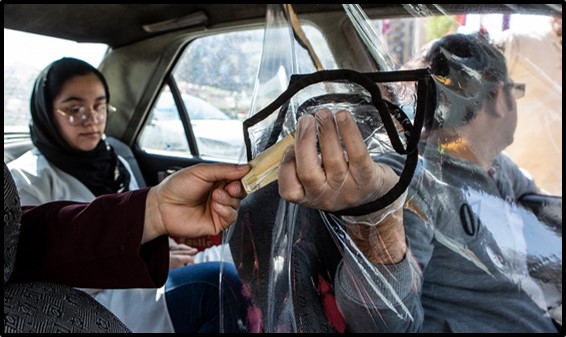
Deputy Health Minister Harirchi announced that all citizens would be required to wear face masks on the subway. He said that masks would be sold for cheap at the entrances to all metro stations.
On April 29, President Rouhani urged Iranians to learn to adapt to life under coronavirus indefinitely. “I’m telling our dear people, because it is not clear when this virus outbreak is over, we should stand ready to keep working and continue to acquire science and knowledge, conduct research, keep the society alive and give hope to the society, with the assumption that unfortunately this virus is here to stay with people for quite some time,” Rouhani said.
On April 30, Jamshid Hamzezadeh, the president of the Iranian Hoteliers Association, said that Iran's tourism industry had lost $330 million of revenue due to the COVID-19 pandemic. Hamzezadeh reported that hotels alone suffered $187 million in losses. He urged the government to exempt the tourism industry from paying taxes.
On April 30, the Ministry of Health announced that religious sites in several cities, including Qom and Tehran, would remain closed through the holy month of Ramadan. "Until there’s full assurance that pilgrims to religious sites will not face problems, we won't allow ourselves to open the doors of these centers to the people," said Health Minister Namaki.
Week 12: May 3 – 9
On May 3, the government designated 132 counties as white — or free of new COVID-19 cases. President Rouhani announced that mosques would be allowed to reopen in those counties on May 4. “The schools in the white and low-risk areas will reopen from May 16,” but he said the government would continue to review the numbers.
Deputy Health Minister Harirchi urged Iranians not to take COVID-19 lightly until a vaccine is developed. Iran had witnessed a decline in new cases and deaths due to government restrictions. “This falling trend in infections came by God’s grace and on the back of people’s cooperation and wholehearted efforts by personnel at all hospitals and laboratories, and all this has happened at a time when we are under unfair sanctions,” Harirchi said.
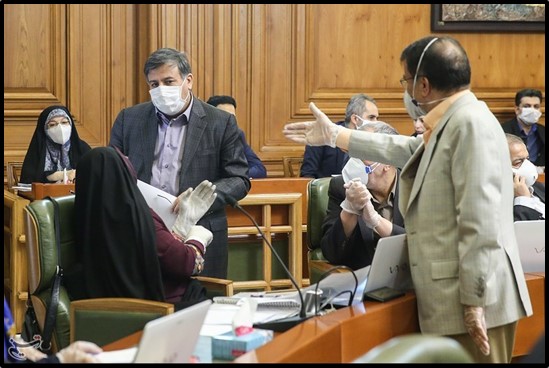
On May 4, Hossein Erfani, the director of the Contagious Disease Department at Iran’s Ministry of Health, warned that the country would likely experience a second wave of coronavirus cases in the autumn. “We predict that after a relative containment of the disease and its decline through the month of Khordad (May 21 – June 20), sporadic cases of the disease would occur in the society, but it will not be fully eradicated,” Erfani said.
Hojjatoleslam Ali Noori, the deputy head of the Policy-Making Council of Iranian Friday Prayer Leaders, announced that Friday prayers could be held in 157 cities after a two-month hiatus. Prayer leaders vowed to respect Ministry of Health guidelines.
On May 5, President Rouhani called on the United States to lift sanctions to help Iran fight its COVID-19 outbreak. “If the Americans are honest amid the conditions caused by the coronavirus and intend to take a measure (in Iran’s favor), the only way is for them to end the illegal sanctions on Iran,” Rouhani said in a phone call with Japanese Prime Minister Abe Shinzo. “Unfortunately, illegal US sanctions against the Iranian nation have intensified in the tough conditions of the fight against the coronavirus and its severe economic consequences.”
On May 6, the Ministry of Health reported that 15 out of the country’s 31 provinces were experiencing a resurgence in COVID-19 cases. The report noted that several tourist destinations—Isfahan, Gilan and Qom—had experienced a second wave of the virus after the government lifted travel restrictions in April.
The government unveiled a $260 million package to aid Iran's health sector. President Rouhani said that the funds were pulled from Iran’s sovereign wealth fund and would go toward the purchase of drugs, diagnostic kits and medical equipment needed to treat COVID-19 patients.
Week 13: May 10 – 16
On May 10, the government closed banks and offices in Abadan in Khuzestan province after the city experienced a sharp rise in new cases. Local officials also closed entry corridors to the city. Gholamreza Shariati, the governor of Khuzestan province, said that the increase was due to inadequate social distancing. “Because of this the number of corona patients in the province has tripled, and the hospitalization of patients has risen by 60 percent,” Shariati reported. Similar restrictions were implemented in nine other cities and towns in Khuzestan.
Supreme Leader Khamenei criticized the West's response to the COVID-19 pandemic. “The West and West-leaning entities wouldn’t like their failure [to counter the pandemic] to be seen, but it is necessary to study and explain the different dimensions of this failure,” he said. “Coronavirus began to spread in the United States and in Europe later than in other countries, which means they had the chance to prepare themselves to counter the virus."
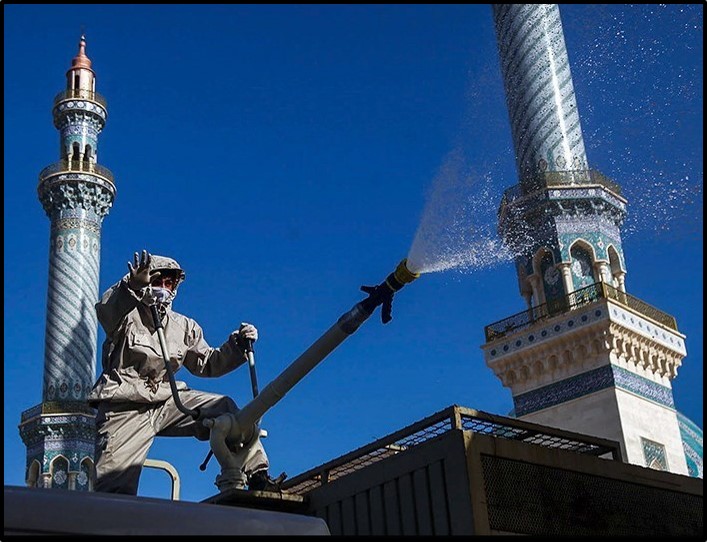
On May 11, Iran Air, the flagship airline, announced that it would partially resume international flights on May 14. Airline officials said that they had gained approval from authorities in the Netherlands to resume flights from Tehran to Amsterdam. Flights would be restricted to diplomats, aid workers, and those holding permanent residency in the Netherlands.
On May 12, the Ministry of Health temporarily reopened all mosques. Mohammad Qomi, the director of the Islamic Development Organization, said that mosques would remain open for three days commemorating specific nights during the holy month of Ramadan.
Health Minister Namaki announced that many regions had entered the "containment phase" in the Iran's fight against COVID-19. He urged citizens to continue to respect health protocols. "Our biggest strategic mistake in the current period is that we’d imagine that the coronavirus is over," Namaki said.
Iran’s transportation minister, Mohammad Eslami, announced that Uzbekistan and Turkmenistan had agreed to resume trade with Iran within 10 days after a two-month suspension due to COVID-19. Eslami said that the countries would implement health protocols on the borders including disinfection facilities for trains and trucks.
On May 13, President Rouhani praised the government's response to COVID-19. "The measures that we witnessed in Iran in the course of the battle with the coronavirus could disprove many judgments that were being made about the establishment, the government and people," he said. "The Westerners imagined that the Iranian nation would not withstand the pressures and sanctions for more than a few months, and after the outbreak of the virus, they thought that a country under tough sanctions and with limited financial sources could not endure such problems."
On May 14, President Rouhani called for solidarity from officials and the public to stem the spread of COVID-19. "I have said time and again that the unity and solidarity among officials at various levels and across the country as well as good cooperation from people were the most important factors, which were key to successful management and control of the deadly coronavirus," he said.
On May 15, the government allotted an additional $995 million to the Ministry of Health to fight the COVID-19 pandemic because the country had experienced an uptick in cases after restrictions were lifted in late April and early May.
On May 16, schools reopened in 130 cities deemed low risk or “white” regions after nearly three months of closure due to COVID-19. Students were required to wear masks and gloves during classes.
The government allocated more than $75 million dollars to Iranians unemployed due to the COVID-19 pandemic. Iran’s Plan and Budget Organization would transfer the funds to the Social Security Organization of Iran for dispersion.
Week 14: May 17 – 23
On May 17, Health Minister Namaki announced progress in Iran's fight against COVID-19. "The country has passed from the stage of managing and controlling the coronavirus disease and is moving towards containing it in most parts of the country," he said.

On May 18, Iran's Revolutionary Guards announced that the country's annual Quds Day parade, in support of the Palestinian claim to Jerusalem, would be cancelled due to COVID-19 concerns. The Guards had initially changed the parade from a pedestrian march to a parade of cars.
Government spokesman Ali Rabiei reported that 280 cities and towns had been declared low-risk white zones. He said that Khuzestan, which accounted for a quarter of the country's new daily cases, was the only region still in the high-risk red category. "We can have fewer deaths, keep people's daily lives in motion and not cripple the economy even when the coronavirus exists."
Health Minister Namaki condemned U.S. sanctions on Iran as "inhumane" in an address to the World Health Organization. "There is no doubt that unilateral sanctions constitute an obstacle and are an inhumane measure, which brings about suffering and pain,” he said. "The United States must be held to account for the severe sanctions that have put the lives of Iranian people in jeopardy."
On May 19, Iran reopened outdoor recreation centers and hiking trails. Minister of Cultural Heritage, Handicrafts, and Tourism Ali Asghar Mounesan said that camping and hiking in large crowds was still prohibited under the new guidelines.
On May 20, Iran announced that it would resume trade with Yemen, the United Arab Emirates, Qatar, Kuwait and Oman. Health Minister Namaki said that Iran would provide them with technical support in disease control.
On May 21, Iran reported that around 10,000 health workers had been infected by COVID-19. In April, the Health Ministry reported that more than 100 health workers had died from the virus.
President Rouhani said that neither the coronavirus nor U.S. sanctions could stop Iran's economic progress. "Coronavirus and problems like that cannot stop our production. Of course such problems have some impacts. Both the coronavirus and the US virus have impacts but none of them can stop us," he said.
Week 15: May 24 – 30
On May 25, President Rouhani announced the country's fourth phase of COVID-19 containment using diagnostic kits and other devices to separate the infected people.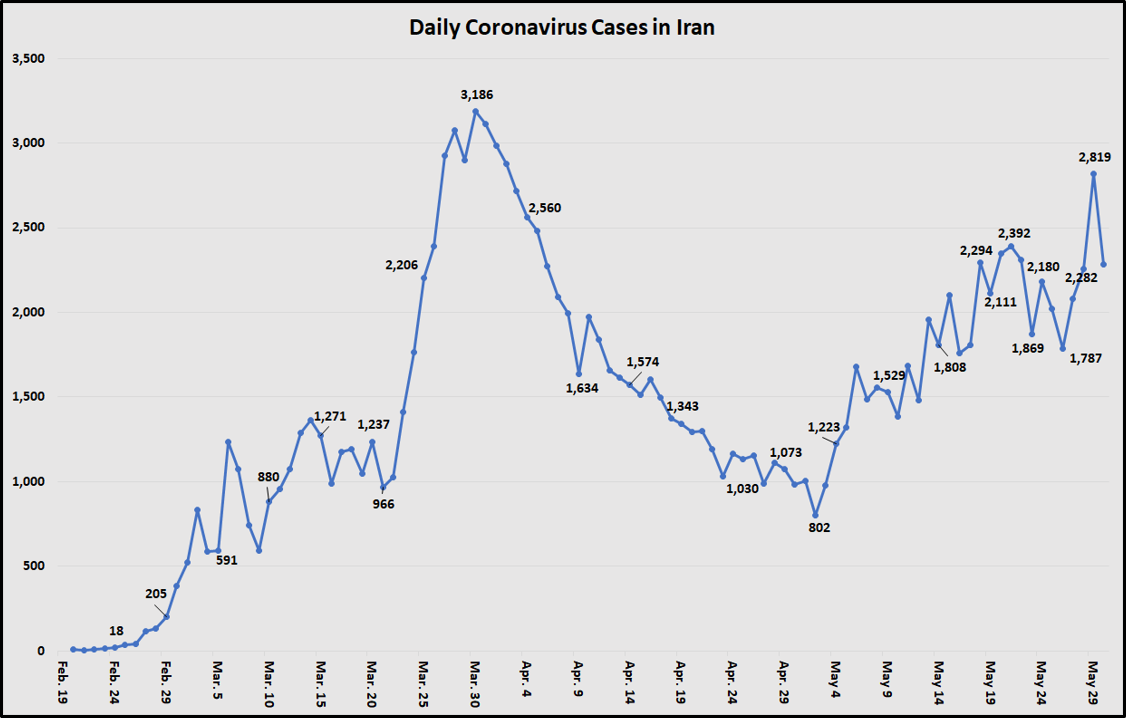
Iran reopened holy sites — including Imam Reza shrine in Mashhad, Fatima Masumeh and Jamkaran mosque in Qom and Shah Abdol-Azim shrine in Tehran — after more than a two-month closure due to coronavirus. Worshippers were required to wear masks, walk through a disinfection tunnel and have their temperatures checked before entering. The shrines would only be opened to the public for six hours each day.
On May 26, "high-risk" businesses — including restaurants, cafes, gyms, saunas and wedding halls — were allowed to reopen across the country. Restaurants were required to ensure a distance of two meters (about 6.5 feet) between all patrons and only at 50 percent capacity.
All border crossings with Afghanistan were reopened and trade restrictions were lifted, according to Hossein Salimi, the chairman of Iran-Afghanistan Joint Chamber of Commerce. Afghanistan closed its land borders to Iran and limited trade on February 23. Land borders were officially reopened on February 25, but trade restrictions had remained in place.
On May 27, Iran’s new parliament, elected in February, held its first session amid the COVID-19 pandemic. All 268 members of parliament who attended had tested negative for the virus, according to state media. Lawmakers had their temperatures checked before entering parliament.
Iran reopened the Bazargan border crossing, which closed on February 24, between Iran and Turkey. Officials announced that Iraq would reopen the Shalamcheh border crossing with Iran the following week. Iraq closed its land borders with Iran on March 8 due to COVID-19. 
On May 30, Iran reopened mosques for daily prayers. Restrictions on the opening hours for shopping malls were lifted.
Week 16: May 31 – June 6
On May 31, President Rouhani praised Iran's response to the COVID-19 outbreak. "Our country’s statistics and figures as well as the economic fallout of coronavirus are comparable to developed countries of the world," he said. "Today, after having fought this dangerous virus for 100 days, during which our health sector and the entire nation did a great job, we see acceptable conditions [in terms of containing the pandemic].”
On June 1, Health Minister Namaki warned that Iran could face a stronger second wave of infections if people did not follow health guidelines. "The outbreak is not over yet and at any moment it may come back stronger than before," Namaki said in a news conference. "If our people fail to respect the health protocols ... we must prepare ourselves for the worst situation."
On June 2, Health Minister Namaki expressed concern that Iranians had become "completely careless" with regard to the COVID-19. "If we neglect the situation, we will go backwards," he said. "People, have mercy on us, let’s have mercy on ourselves, government officials are getting tired."
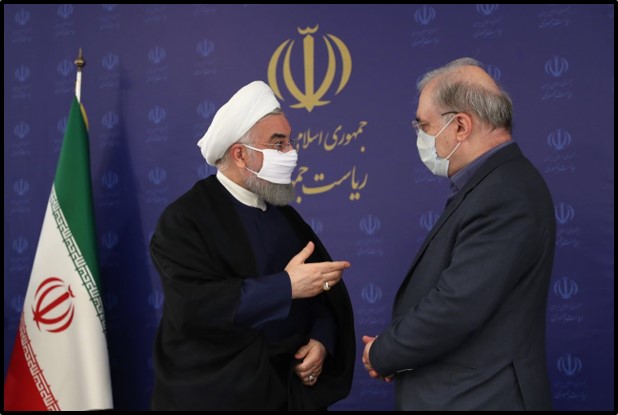
On June 3, President Rouhani warned that Iran would reimpose restrictions if a second wave of infections hit the country. "If in any part of the country these warnings aren’t taken seriously and God forbid the outbreak of illness peaks again, the authorities will have to reimpose restrictions," he said. "This issue will create problems for the ordinary life of citizens and will also bring serious economic damage to the society." He urged Iranians to avoid nonessential travel.
On June 5, Iran's tourism ministry announced that the country could reopen to foreigners by mid-summer. "Based on our tourism marketing program monitoring and data analysis from the neighboring countries, the Persian Gulf littoral states, and the European Union, an initial forecast suggests that Iran will open land borders to neighbors as of 15th of Tir (July 5) and some of its air borders as of 1st of Mordad (July 22)," said Mohammad-Ebrahim Larijani, the director of the ministry’s advertising and marketing office. "We are constantly monitoring countries and we have decided, in the first phase, to resume tourism interactions with the neighboring countries."
On June 6, President Rouhani warned that the COVID-19 outbreak was not over. "The period of the coronavirus epidemic is going to be long, and we don’t know when it will end; under such circumstances, health directives must be closely observed," Rouhani said. "Meeting the needs in the health and treatment sector to fight coronavirus, supplying necessary services to society, providing basic and essential goods, and supplying stimulus packages to low-income families are four main duties of the government, and the trend of discharging all these responsibilities is going well."
President Rouhani blamed a wedding party for the latest surge in COVID-19 cases. “At one location, we witnessed a peak in this epidemic, the source of which was a wedding that caused problems for the people, health workers and losses to the economy and the country’s health system,” Rouhani said on state television.
President Rouhani announced that theaters and concert halls would reopen on June 21. The Ministry of Health limited seating capacity to 50 percent for all venues.
Week 17: June 7 – 13
On June 7, the Ministry of Health said that Iran's spike in coronavirus cases was due to increased testing. "The main reason for rising numbers is that we started identifying (infected people) with no or light symptoms," said Mohammad-Mehdi Gouya, the health ministry's head epidemiologist. He added that it was normal for a slight rise in infections after reopenings.
Iran announced that it would allow foreign students to return to universities in Iran on September 5. Abdolhamid Alizadeh, the director general of the Iranian Science Ministry’s office of foreign students, said that 15,680 foreign students had left Iran in March due to the coronavirus outbreak.
On June 8, Health ministry spokesman Kianoush Jahanpour urged citizens to wear masks to stem a second wave of coronavirus infections. "Everybody must wear masks when attending places like stores or any other place where it is not possible to observe social distancing carefully," Jahanpour said on state television.
On June 9, the Ministry of Health estimated that about 15 million Iranians, nearly one in fifth of the population, had been infected with COVID-19. This means the virus was "much less lethal than we or the world had anticipated," said Ehsan Mostafavi, a member of the country's COVID-19 task force.
Health Minister Namaki dismissed Health Ministry spokesman Kianoush Jahanpur after several of his controversial tweets and comments to the media. Namaki said that the spokesperson was required to get approval before expressing personal opinions on social media. Dr. Sima Sadat Lari, the Students Affairs Deputy of the Ministry, was appointed as the new spokesperson. Namaki urged Lari to refrain from "political games" and concentrate on the ministry's mission.
#Iran’s Health Ministry new spokeswoman: Total #CoronaVirus cases in Iran are now 175,927 & number of deaths 8425. As of yesterday 2095 new infections & 74 deaths reported. 138,457 have so far recovered from #COVID19 & 2639 are in critical condition. 1,128,601 tests done so far. pic.twitter.com/yBmWTpKWQl
— Abas Aslani (@AbasAslani) June 9, 2020
Ehsan Mostafavi, the head of the Research Center for Emerging and Reemerging Infectious Diseases at the Iran's Pasteur Institute, said that Iran had a lower mortality rate than many other countries because of its young population and widespread testing. "One determining factor is the younger population of the country. The median age in Iran is 31, while it’s 45 in Spain and 47 in Italy," Mostafavi said.
On June 13, President Rouhani urged citizens to continue to adhere to health protocols, warning that the population had not reached "collective immunity" from the virus. "No matter how advanced the country is, the number of beds and medical facilities as well as medical personnel is limited, so everybody should keep observing directives," Rouhani said.
Week 18: June 14 – 20
On June 14, Iran recorded 107 deaths from COVID-19, the country's largest daily increase in fatalities since April 13. "Today it was very painful for us to announce a triple digit statistic... This virus is unpredictable and shifting," said Health Ministry spokeswoman Lari. "Observe health protocols, take social distancing seriously, avoid gatherings and trips that aren’t essential and, God willing, in the coming days we will see the statistic come down into double digits and even single digits."
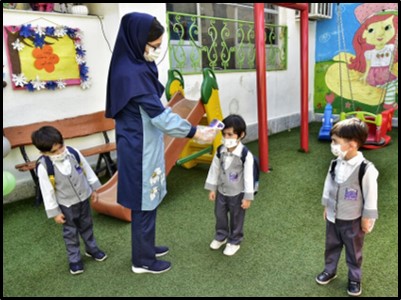
On June 15, Iran reopened kindergartens across the country. The Ministry of Health restricted capacity to 50 percent and required all children to have their temperatures checked before entering the classroom.
Government spokesman Ali Rabiei warned that Iran may have to reimpose restrictions after a surge in coronavirus infections and deaths. "In the (Tehran) subway, although 90 percent of passengers use masks, social distancing is not being observed," Rabiei said during a news conference. If the virus spreads is out of control, the government would have to apply strict limitations again.
On June 16, President Rouhani said that Iran was engaged in two separate battles, one against COVID-19 and another against "cruel and inhumane" U.S. sanctions. "One of the country’s glories in simultaneous handling of the sanctions and the coronavirus has been fulfillment of the necessary needs of people in the market, in such a way that we prevented the inhumane dream of those imposing sanctions from coming true, which was causing problems and distress in the daily economic lives of people and the supply of items they need for livelihood," Rouhani said.
On June 17, three prominent Iranian physicians wrote to President Rouhani urging him to prioritize "preserving people's lives and health to everything else." The doctors called on the government to reimpose health restrictions to stem the country's second wave of infections.
On June 18, President Rouhani said that the coronavirus outbreak has not stopped Iran's economic progress. He pointed to several new national projects in the transportation industry. "Thank God, we are witnessing very good movements in the maritime routes and the ports, particularly in Chabahar, as well as in the railroad and land transportation," Rouhani said at a project inauguration ceremony in Tehran.
On June 20, President Rouhani said that Iran may require citizens to wear masks in public places. "Mainly for crowded and covered areas...we may make (masks) compulsory in a week, more or less. But first plenty of inexpensive masks should be made available for the people," he said on state television.
Week 19: June 21 – 27
On June 21, Health Minister Namaki said that Iran was still battling the first wave of COVID-19 infections. "The peak of the disease has not passed. The coronavirus is a tricky virus with a hundred thousand faces. A protocol for treatment may be effectual in one region, but ineffective in another area," he warned.
On June 22, Education Minister Mohsen Haji Mirzaei announced that students at large schools would begin attending school on alternate days in the new school year.
Health Minister Namaki said that 87 percent of Iranians who had died from COVID-19 were obese or had underlying medical issues.
On June 23, Iran reported 121 new fatalities from COVID-19, the country's highest daily increase in deaths since April 11. After a decrease in deaths in May, daily fatalities related to COVID-19 slowly increased in June.
On June 24, Deputy Health Minister Raeesi announced that 40 percent of residents in Qom and Gilan provinces and 15 percent of residents in Tehran province had contracted COVID-19. He added that the extent of infections in Iran's other provinces was between four and five percent. Health Minister Namaki said that Iran was working toward developing its own vaccine. "We have made good progress, but it is still too early to unveil our work,” Namaki told reporters. The Health Ministry said it was offering free COVID-19 tests to anyone with symptoms.
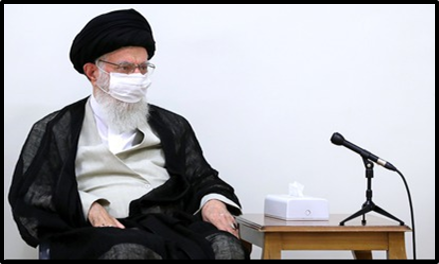
On June 26, Ali Asghar Mounesan, Iran’s minister of cultural heritage, tourism and handicrafts, said that country's tourism industry had started to recover from the COVID-19 pandemic. "Local tourism in the country has now begun with all the health protocols in place, and, as of early August, with the plans that have been made, we will see the presence of foreign tourists in the country again," Mounesan said in a radio interview.
Musa Alizadeh-Tabataee, Iran’s deputy ambassador to Iraq, announced that all border points with Iraq would be opened soon. He said that 80 percent of the crossings were already open with new health protocols. Other points along the southern border were still closed, he added.
On June 27, Supreme Leader Ayatollah Khamenei warned that Iran's economy could further deteriorate if the country did not stem COVID-19. "Something must be done to prevent economic problems caused by the coronavirus," he said in a meeting with judiciary officials. "But in the case of negligence and significant spread of the disease, economic problems will increase, too."
The Ministry of Health launched an “#I_wear_mask” campaign to promote health protocols on social media. "I desperately - and in a friendly way - plead with people to cooperate in observing medical protocols for their own sake and that of others," Deputy Health Minister Harirchi told reporters. "Every 33 seconds one Iranian is infected with the coronavirus and every 13 minutes one dies from it."
Week 20: June 28 – July 4
On June 28, President Rouhani announced that all citizens would be required to wear masks at indoor gatherings starting on July 5 to stem the spread of COVID-19. The new protocol would remain in effect until July 22.
On June 30, President Rouhani warned that the coronavirus would likely linger in the country throughout the Persian year, which ends in March 2021. "Watchfulness and observance of the health principles must still be on the agenda of everybody, and attending the unnecessary gatherings must be avoided," Rouhani said. "Despite all efforts and the very good measures that have been taken in the fight against the disease and for the treatment of the patients, we still witness an increase in the number of infections in a number of cities because the coronavirus is unknown."
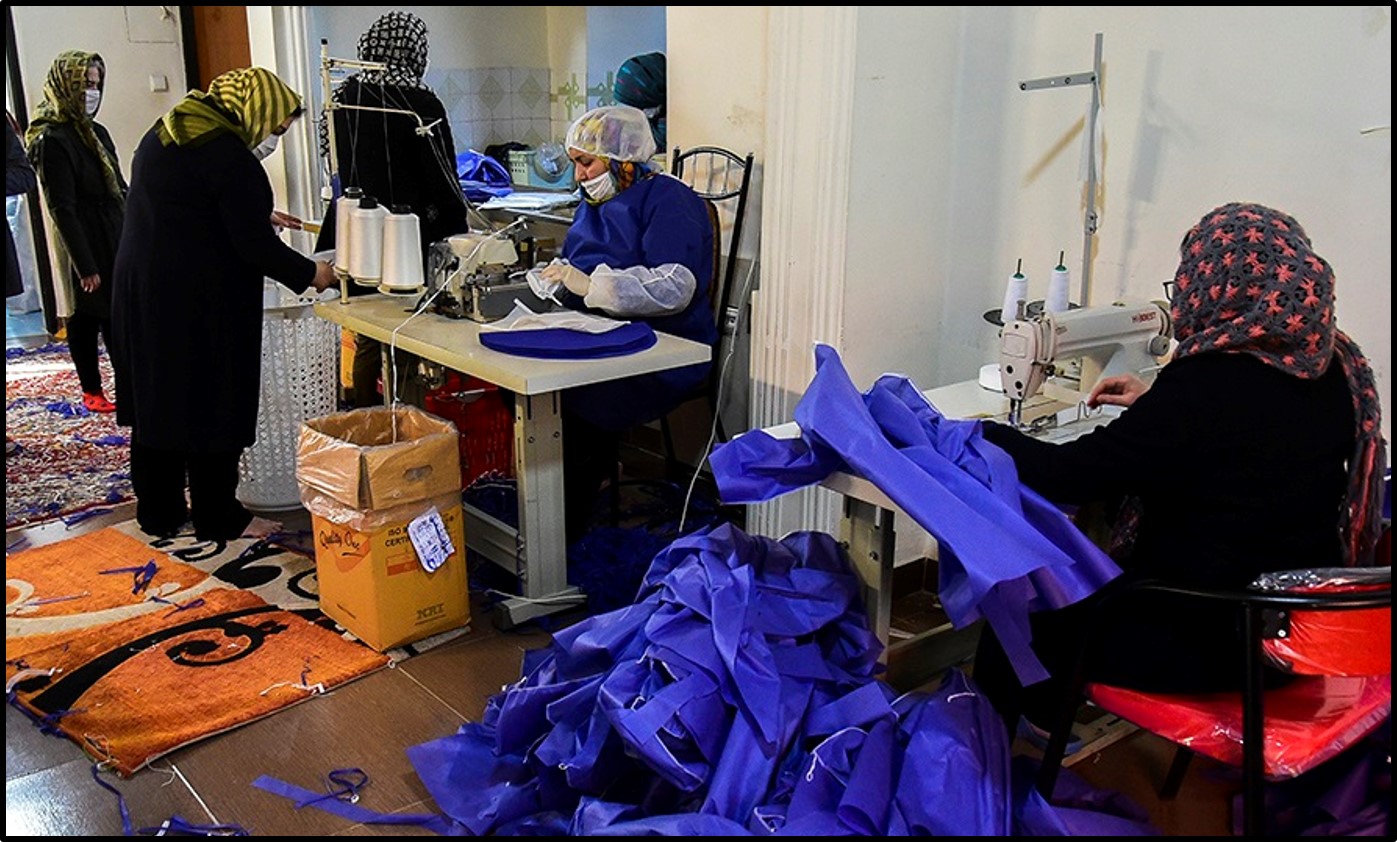
Iran announced that a homegrown COVID-19 vaccine would undergo human clinical trials "in the not too distant future." Health Minister Namaki said that the vaccine had already passed laboratory tests with animals.
On July 1, the Ministry of Cultural Heritage, Tourism, and Handicrafts held a meeting to determine rules for foreign tourists. "Given the fact that some countries, especially neighboring countries, are gradually re-opening borders, the Islamic Republic of Iran needs to take action to define comprehensive health protocols," said Vali Teymouri, the deputy tourism minister.
On July 3, Iran reintroduced a week-long lockdown on seven cities in the southern province of Hormuzgan, including Bandar Abbas, one of the country's biggest port cities on the Persian Gulf. The shutdown included all schools, universities, most offices, cinemas, restaurants, public pools, gyms and parks. Hormozgan Governor General Fereydoun Hemmati said that the province had experienced an uptick in cases and fatalities due to tourists and overcrowded bazaars.
On July 4, President Rouhani warned citizens not to hide infections. "If someone knows that they have been infected with coronavirus, they have a religious and human duty to inform others about it," Rouhani said. "If somebody has found out that another person is infected, they should reveal it, so that we will be able to get through this problem."
Week 21: July 5 – 11
On July 6, Iran banned the export of face masks amid an uptick in infections. Jamshid Golpour, head of the Industry and Trade Ministry’s Center for Guilds and Businesspeople, called on vendors to increase domestic sales of masks. “Producers are expected to provide distribution networks with standard masks at already approved prices," he said.

On July 7, Iran reported 200 new deaths, exceeding the previous record of 163 deaths on July 5. "I repeatedly said to our people that it’s extremely dangerous to understate the situation," Health Minister Namaki said on state television. "Unfortunately, our pleas fell on deaf ears until we were gripped by a new wave."
On July 8, Health Minister Namaki blamed "criminal" U.S. sanctions for Iran's struggles to contain COVID-19. He also criticized Iranian officials, accusing them of "negligence," having no economic plan, and "losing control" of the outbreak. "This country’s president must think about the people’s livelihood. This country’s administration, the security forces, the law enforcement, and the military forces must think about the livelihood and how to prevent an insurrection," he said.
Iraq partially reopened the Shalamcheh border crossing with Iran after more than three months. Trade was restricted to 500 trucks per week to transport food and other essential items. Both governments implemented new health protocols at the border.
On July 9, Iranian Parliament Speaker Mohammad Baqer Qalibaf accused the United States of hampering Iran's efforts to fight COVID-19. He called on the international community to condemn "inhumane" U.S. sanctions. "Since the outbreak of the dangerous virus, despite pressures and calls from international organizations to halt or reduce the U.S.-led sanctions against various nations, including Iran, Washington’s maximum pressure has been on the rise," he said.
General Hossein Salami, the IRGC commander, called on citizens to follow health protocols. "The coronavirus is not weakening and is still active, affecting new areas every day, and we should not show weaknesses," Salami said. "As no decisive treatment currently exists, we can only tackle this disease by following the health protocols and taking preventive measures."
On July 11, President Rouhani warned that a nationwide lockdown could disrupt economic activities and prompt protests. "The easiest option is to shut down everything," he said. "But then people will pour into the streets because of hunger and unemployment." But he did call for a ban on weddings, funerals and other ceremonies. "Now is not the time for festivals or seminars," he said. Shortly after Rouhani's speech, Ali Reza Zali, the head of Tehran’s virus task force, announced a ban all conferences, festivals and exhibitions and restricted wedding and funeral ceremonies to 10 people. The number of COVID-19 testing centers in the capital was also almost doubled, from 56 to 90, as the pace of the pandemic accelerated.
Hossein Qenaati, an advisor to Iran’s Coronavirus Task Force, said that between 50,000 and 60,000 Iranians could die from the virus if the public did not adhere to health protocols. "The second wave, which will occur in the fall, will be much more deadly," Qenaati warned.
Week 22: July 12 – 18
On July 13, Supreme Leader Ayatollah Khamenei called the resurgence of COVID-19 "truly tragic" in a virtual meeting with lawmakers. Khamenei urged all citizens to "play their part in the best way to break the chain of transmission in the short term and save the country."
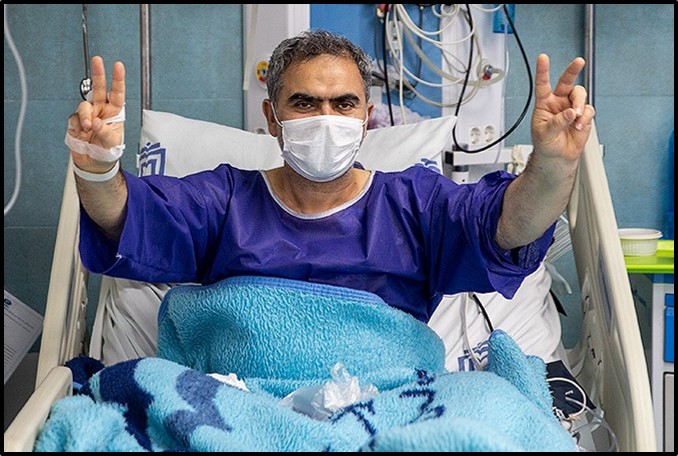
On July 14, Anushirvan Mohseni Bandpay, the governor of Tehran Province, reimposed a week-long lockdown after a spike in COVID-19 cases and deaths. The new restrictions, made in coordination with the National Coronavirus Task Force, shutdown all universities, schools, seminaries, libraries, theaters, museums, ceremony halls, barbershops, beauty salons, mosques, cafeterias, coffee shops, zoos, amusement parks, indoor swimming pools, and fitness centers. Bandpay also declared a ban on social, cultural and religious gatherings.
Health Ministry spokesman Lari announced that 12 provinces had been declared "red zones" — up from nine — due to high rates of COVID-19 infections. The red provinces included Khuzestan, West Azarbaijan, East Azarbaijan, Khorasan Razavi, Zanjan, Kurdistan, Kermanshah, Golestan, Hormozgan, Ilam, Bushehr, and Mazandaran.
Mahmoud Abbasi, the Deputy Justice Minister for Human Rights and International Affairs, said that anyone who had knowingly spread COVID-19 should be hanged. "Someone who is fully aware of his infection and without wearing a mask sneezes and coughs…spreads the coronavirus to others and ultimately causes their death. This means deliberate murder and is subject to Qisas," Abbasi told a local news outlet.
On July 15, Health Minister Namaki announced that Iran would begin producing Remdesivir, an antiviral agent proven to treat COVID-19, within a week. Iran had previously relied on humanitarian imports to receive the drug.
On July 16, Reza Jalili-Khoshnood, a senior official on Tehran’s anti-coronavirus task force, warned that the country was facing a shortage of medical staff and beds. He said that 172 medical personnel had been infected at Tehran’s Shohada hospital alone.
Iran’s Friday Prayers Committee announced that Friday prayers were cancelled in Tehran due to the increase in COVID-19 cases and deaths in the city. Prayers were allowed to continue in provinces deemed “white zones” due to low numbers of infections.
On July 18, President Rouhani said that 25 million Iranians may have been infected with COVID-19 and about 14,000 had lost their lives, based on a Ministry of Health study. “There is the possibility that between 30 and 35 million more people will be at risk.”
President Rouhani said that the country’s COVID-19 outbreak had probably started in Qom and Gilan provinces, where people who had traveled to Wuhan, China spread the virus to students and tourists. He blamed the second wave of infections on the public’s refusal to adhere to government-imposed health protocols.
The governor of Khuzestan announced that 22 cities in the southwestern province would be placed under a three-day lockdown to stem the spread of the virus. Khuzestan had some of the highest rates of infections and deaths in the country.
Week 23: July 19 – 25
On July 19, Turkey suspended all flights to Iran due to the increase in COVID-19 cases.

On July 21, Iran recorded 229 new deaths from COVID-19, the largest one-day increase in deaths.
On July 22, Iran unveiled the domestic production of two drugs — “Remdesivir” and “Favipiravir” — to help treat COVID-19 patients.
On July 23, Health Minister Namaki told the World Health Organization (WHO) that Iranian scientists had made progress in a COVID-19 vaccine. It “passed the initial tests and (we) hope to reach promising stages,” Namaki said.
On July 24, Iraq reopened the Khosravi border crossing with Iran after four months.
Abbas Mousavi Motlaq, the Friday Prayer Imam in Qom, said that COVID-19 was a “secular virus” that was corrupting religious countries. “With its destructive effects coronavirus is trying to lead religious countries astray, and toward atheism,” he said.
Week 24: July 26 – August 1
On July 25, President Rouhani urged citizens to be cautious during celebrations for the Islamic holiday of Eid al Adha. “Let glorious festivities be held in mosques and religious centers by observing health protocols and social distancing,” Rouhani said. Deputy Health Minister Harirchi urged people not to travel to the holy city of Mashhad during the festivities because it had a 300 percent increase in COVID-19 cases in the previous month.
In an open letter, Tehran’s Coronavirus Task Force asked Health Minister Namaki to allow half of the city’s government employees to work remotely. Under protocols at the time, only one-third of Tehran’s government employees were permitted to work remotely.
On July 26, Health Ministry spokeswoman Sima Sadat Lari called on the public to follow health protocols to ease pressure on exhausted medical workers. “Our biggest concerns are the infection and fatigue of medical staff,” she said.
On July 27, Iranian state media announced that government spokesman Ali Rabiei had tested positive for COVID-19. Rabiei had reportedly been hospitalized but was in good condition.
Habibollah Sayyari, the Deputy Coordinator of Iran's Army, called on the military to continue efforts to contain the virus. “More than 12,000 Army personnel are now active in different healthcare sections, including hospitals and laboratories, to contain the pandemic,” he said.

On July 28, Iran recorded 235 new deaths from COVID-19, the highest daily death toll since the outbreak began. Arash Anisian, the director of the private Ebnesina Hospital in Tehran, warned that nearly 20 percent of the emergency ward staff and 40 percent of supervisors had contracted the virus. “Replacement under such difficult conditions is very hard. We have to pay more to our personnel, for longer hours and for hardship of the job,” Anisian told The Wall Street Journal. “But we cannot charge patients more. So our hospital is under extreme financial pressure.”
Health Minister Namaki said that Iran’s progress in developing a homegrown vaccine was on par with other advanced countries. “We don’t want to make delusional comments and don’t want to say that the vaccine would be available to the public until autumn,” Namaki said at a ministry meeting. “Today, we can only say that we are not lagging behind many in the world who claim to have produced the vaccine.”
Foreign Minister Zarif said that the COVID-19 pandemic will significantly alter the world order. “Throughout history, the old order has collapsed and been replaced with a new one after widespread bloodshed,” he told a conference in Tehran. “I believe that absolute Western approaches have failed to provide us with a true understanding of global events. The modern international order will not be totally Western anymore.”
On July 30, former parliament speaker Ali Larijani tested positive for COVID-19 for a second time. Larijani was reportedly in good condition under quarantine in a Tehran hospital.
President Rouhani announced that most Iranian provinces were past the peak of the pandemic. “All Iranian provinces, except two, are leaving behind the coronavirus peak,” he said.
Deputy Health Minister Qassem Janbabayee accused Britain of “hijacking” mask shipments already paid for by Iran.
On July 31, Amnesty International published four leaked letters from Iranian prison officials, which purportedly revealed the Iranian regime had “ignored pleas by senior officials” for additional resources to treat the COVID-19 outbreak in prisons. “These official letters provide damning evidence of the government’s failure to protect prisoners. Urgent requests for resources have been ignored for months,” said Diana Eltahawy, Amnesty’s Deputy Regional Director for the Middle East and North Africa. “Overcrowding, poor ventilation, lack of basic sanitation and medical equipment, and deliberate neglect of prisoners’ health problems, are making Iranian prisons a perfect breeding ground for COVID-19. The Iranian authorities must stop denying the health crisis in Iran’s prisons and take urgent steps to protect prisoners’ health and lives.”
On August 1, President Rouhani announced a nationwide ban on all public gatherings for a week. “Until further notice, all gatherings, including weddings, wakes and parties, are banned. This is no longer provincial; it is nationwide, until there is a change in the situation,” he said. He also called on local authorities to prosecute those who violate health protocols. “There is no doubt that we need to take action against violators of health measures,” Rouhani said. “Until the day the Health Ministry announces the availability of a vaccine, we need to observe the rules and continue enforcing strict measures.”
Week 25: August 2 – 8
On August 1, a BBC Persian investigation estimated that deaths from COVID-19 could be three times higher than the official tally. Government documents from an anonymous source showed that nearly 42,000 people had died with COVID-19 symptoms as of July 20, when the health ministry had reported only 14,405 deaths. “BBC can confirm that the lists include the names and details of individuals who have either died of COVID-19 or with similar symptoms or visited health centers or were hospitalized due to confirmed COVID-19 or similar symptoms,” the BBC reported.
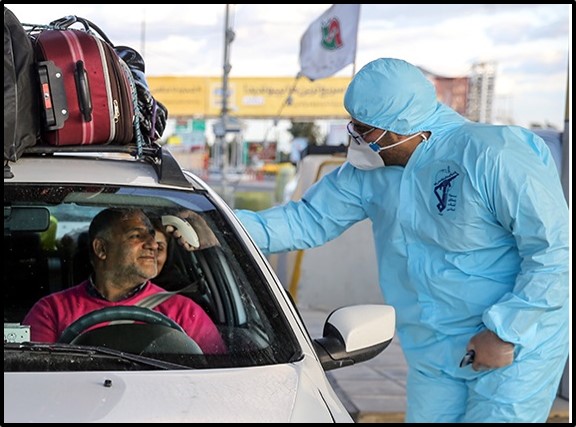
On August 3, state television revealed that one Iranian was dying from COVID-19 every seven minutes.
On August 4, Ali Asghar Mounesan, Iran’s tourism minister, said that the threat of coronavirus should not bring tourism to a complete halt. “Corona is a fact, but can the virus stop tourism? Certainly not. For us, the coronavirus is a new experience in dealing with crises that teaches tourism experts around the world how to deal with such a disaster, and thankfully governments are turning this into an opportunity for better planning,” he said.
On August 5, Alireza Salimi, the deputy on Iran’s Medical Council, warned that the development of a vaccine for COVID-19 over the next few months was unlikely. “The only thing in our power is to break the chain of transmission, plan for the continuation of the cycle of life, and minimize the death rate,” Salimi said.
On August 8, President Rouhani urged officials to find a balance between stringent restrictions and completely reopening the country. “We must follow a moderate path because it is not possible to continue with severe restrictions,” the president said. “We cannot completely shut down economic, educational and cultural activities, even if these activities cannot be the same as before coronavirus. We have no choice but to continue with our activities, but to also follow health protocols completely.”
Week 26: August 9 – 15
On August 9, President Rouhani announced that the nationwide state of emergency due to the pandemic would remain in effect until at least January 2021. “We have been in this situation for six months, and we must prepare ourselves for another six months at least,” Rouhani said. “We must find a middle way between normality and sticking to the virus restrictions.”
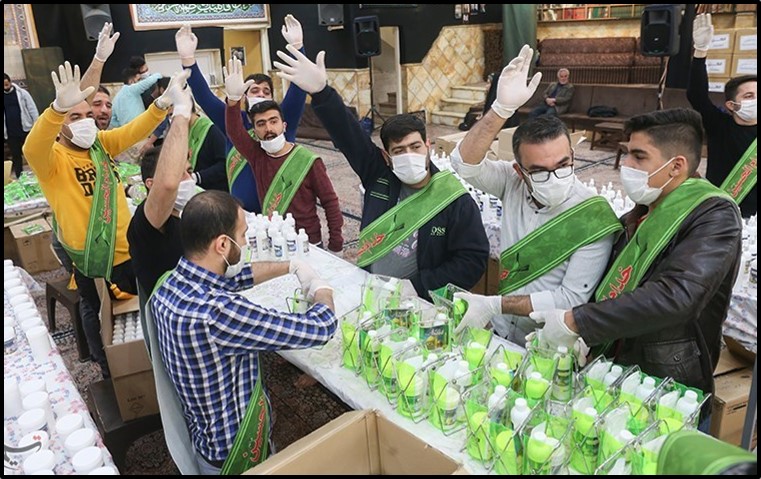
Mohammad Qasemi, the director for marketing and advertising at Iran’s Ministry of Tourism, said that Tehran was developing all-inclusive health protocols for foreign tourists. He added that new regulations would help bolster tourism in the long run by stemming the spread of the virus.
On August 10, Iran shut down Jahane Sanat, a daily newspaper, for publishing an interview with an epidemiologist who said that the government tally of COVID-19 cases and deaths only accounted for five percent of the real toll. “There was no transparent flow of information,” Mahboubfar said. “The government only provided engineered figures...over concerns about (its impact) on the election and the commemorations of the revolution anniversary.” A Health Ministry spokeswoman denied the claim and said that ministry were transparent. “The Health Ministry is not a political body and health of people is its main priority,” she added.
On August 11, the Center for Human Rights in Iran (CHRI) reported that 12 political prisoners in Evin Prison — including prominent labor leaders Esmail Abdi and Jafar Azimzadeh, human rights lawyer Amirsalar Davouudi and journalist Majid Azarpey — had tested positive for COVID-19. The outbreak in Evin's Ward 8 started in late July, according to Abdi's wife. The infected prisoners were reportedly admitted to the prison clinic. "By keeping political prisoners in overcrowded and unsanitary prisons where they are denied medical care and are not separated from ill prisoners, the Iranian authorities are condemning these individuals to COVID-19 and possible death," said Hadi Ghaemi, the executive director of CHRI.
Esmaeil Mousavi, the spokesman for Iran’s Elections Headquarters, announced that all campaigning for the second round of parliamentary elections would be conducted virtually. Mousavi said that the elections would proceed as scheduled on September 11 after they were postponed in mid-April due to the COVID-19 pandemic. He added that voting would be held in “open spaces” to stem the spread of the virus.
On August 14, Dr. Alireza Zali, the head of the Tehran Coronavirus Combat Taskforce, said that the government had made a “strategic mistake” by relying on citizens to observe social distancing guidelines. During a press conference, he criticized the government for lifting restrictions and lockdowns prematurely. “The effectiveness of the government actions will be affected if public trust is marred for any reason,” Zali added.
On August 15, President Rouhani announced that 10,000 additional hospital beds and 2,000 ICU beds would be prepared by March 2021. Rouhani also said that the government would allocate a budget to the education sector to develop better online learning platforms.
Week 27: August 16 – 22
On August 17, Iranian Minister of Tourism Ali Asghar Mounesan said that the country’s tourism industry had lost $2.85 billion due to the pandemic.
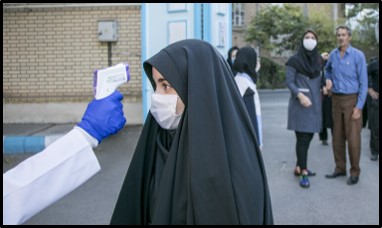
On August 18, Dr. Alireza Zali, the head of the Tehran Coronavirus Combat Taskforce, called for a two-week extension of lockdown restrictions in Tehran. “Despite an 11 percent decline in suspected Covid-19 patients visiting hospitals, Tehran Province is still on red alert,” he told reporters.
Iran said that it would wait for the approval of the World Health Organization before buying Russia’s coronavirus vaccine. “In order for the vaccine to be used, genuine and independent organizations such as the World Health Organization must comment on it and approve it, which has not happened yet,” he said.
On August 21, worshippers began rituals for the Islamic holy month of Muharram, including mourning ceremonies commemorating the killing of the Prophet Mohammed's grandson Hussein. The National Coronavirus Combat Taskforce banned annual marches, musical performances and banquets, and all indoor ceremonies. Masks and social distancing were required at outdoor venues.
On August 22, Mohammad Lahouti, the head of Iran’s Export Confederation, said that non-oil exports had declined by 39 percent due to the pandemic. “The president has announced a reduction of 10 percent in the country's economic dependence on oil, which is unprecedented,” he said. “A country, which for years relied solely on the oil, is now facing conditions that have forced it to break its dependence on oil and to move toward a non-oil economy.” U.S. sanctions, reimposed in 2018, severely curtailed Iran’s ability to sell oil.
Health Minister Namaki said that 164 health professionals had died from COVID-19.
Iran resumed flights to the Iraqi city of Basra. It was the first flight between the two countries since mid-March.
Week 28: August 23 – 29
On August 23, President Rouhani said that Iran’s economy had only shrunk by three percent during the COVID-19 pandemic. He praised the country’s resilience, adding that other countries’ economies had decreased by up to 20 percent.
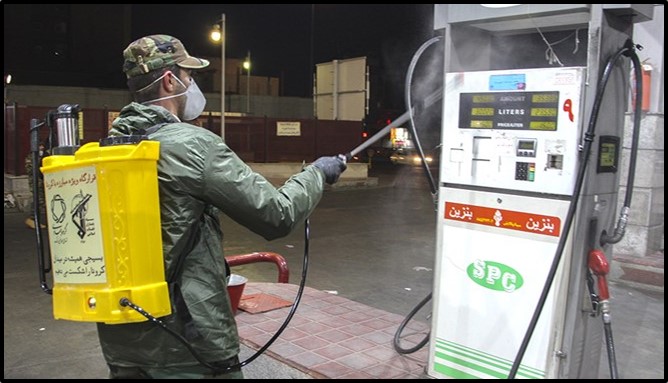
Nahid Khodakarami, a member of the Tehran city council, said that 10,200 residents of Tehran had died from coronavirus since February. He warned that Muharram mourning ceremonies could cause a third wave.
The Ministry of Health said that all foreign national infected with COVID-19 had received free medical treatment in Iran. Iran had spent nearly $95 million in medical expenses for registered foreigners since the pandemic began, according to Shahnam Arshi of the Ministry of Health.
On August 25, Health Minister Namaki warned against public complacency during the Islamic holy month of Muharram. “I am asking people not to pack bags and hopscotch around the country just because their children are done with university entrance exams,” he said. “If citizens travel again, we should expect the resurgence of the virus one week after the holidays,” Tehran Governor Anoushirvan Mohsen Bandpey added.
On August 26, Iran’s Central Taskforce for Coordinating Travel Services announced that travel and tourism would be permitted during the Muharram holiday season despite warnings from health officials.
On August 29, Health Minister Namaki blamed the “ignorance and nonchalance” of holiday travelers for putting the country’s medical workers at risk. “I wish I had the power, authority, instruments or assistance beyond begging, requesting and pleading,” he said.
Week 29: August 30 – September 5
On August 30, thousands of worshippers gathered across Iran to celebrate the holiday of Ashura, an annual day of mourning for Shiite Muslims. Indoor rituals were banned, and the government required all participants in outdoor ceremonies to wear masks and practice social distancing. President Rouhani praised the mourners for observing health protocols but expressed concern with a spike in holiday travel. “Those who have travelled during the recent holidays should not allow their non-compliance with protocols to cause a new escalation of the COVID-19 outbreak and negatively affect the hard work of the medical staff,” he said.
Deputy Health Minister Ghasem Jan-Babaei criticized travelers vacationing in Iran’s northern provinces. “Health workers are doing everything in their power to serve the people but they are exhausted because some disregard the guidelines,” he said. “More serious action must be taken against those who travel regardless of the guidance. But this is not the Health Ministry’s job and authorities in other areas must enforce the restrictions.”
President Rouhani said that Iran planned to purchase trial vaccines developed by foreign countries while still conducting its own tests and trials.
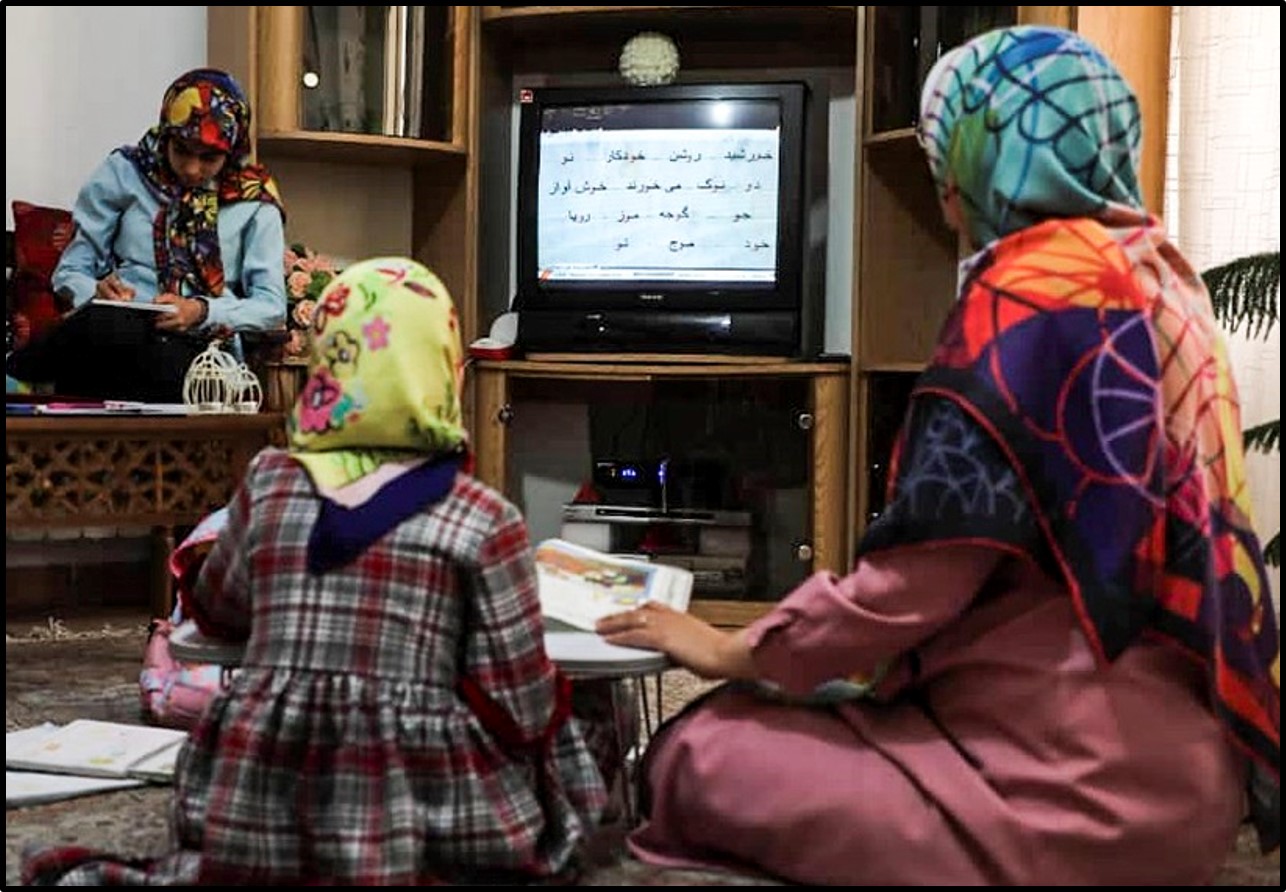
On August 31, Education Minister Mohsen Haji Mirzaei announced that schools in high-risk regions, including 13 of Iran’s 31 provinces, would not be allowed to reopen until rates of COVID-19 dropped. “Even if students do not have access to television, we will prepare learning packages and pursue education via contact with teachers,” he said. “Some 35 percent of nationwide classes, where social distancing is possible, will return to normal while following safety rules.”
The Administrative and Recruitment Affairs Organization of Iran issued a policy for reprimanding government employees who ignored health protocols at work. After the first violation, employees would receive a written warning. After a second offense, employees would be issued a citation to be documented in their employer’s records. If the employee committed a third violation, he or she would receive a one-third cut in salary for that month.
On September 3, Health Minister Namaki announced a vaccine development committee. Dr. Mohammad Mahdi Gooya, the head of the Health Ministry's Communicable Diseases Center, was tapped to lead the committee including health experts from the public and private sectors.
On September 5, schools reopened to 15 million students after seven months. Students were required to follow strict health protocols, including social distancing, masks, and temperature checks. “School is an environment. We cannot bring that environment to homes with applications [software]; the right path for education has been chosen,” President Rouhani said. “This year, teachers should educate, keep schools safe, preserve the health of children and improve learning skills.”
President Rouhani criticized the international community for not shielding Iran from U.S. sanctions during the pandemic. “Over the past months since the coronavirus arrived in our country [and] no one came to our help,” Rouhani said. If the United States “had a bit of humanity and brain,” it would have offered to “lift the sanctions for a year because of the coronavirus.”
Week 30: September 6 – September 12
On September 6, Mohammad Reza Zafarqandi, the head of Iran’s Medical Council, blasted the Ministry of Education’s decision to reopen schools. It will “no doubt lead to an increased burden on the country's medical workers,” Zafarqandi said in an open letter. “When an epidemic hit, schools are the first places that should be closed and the last to be reopened.”
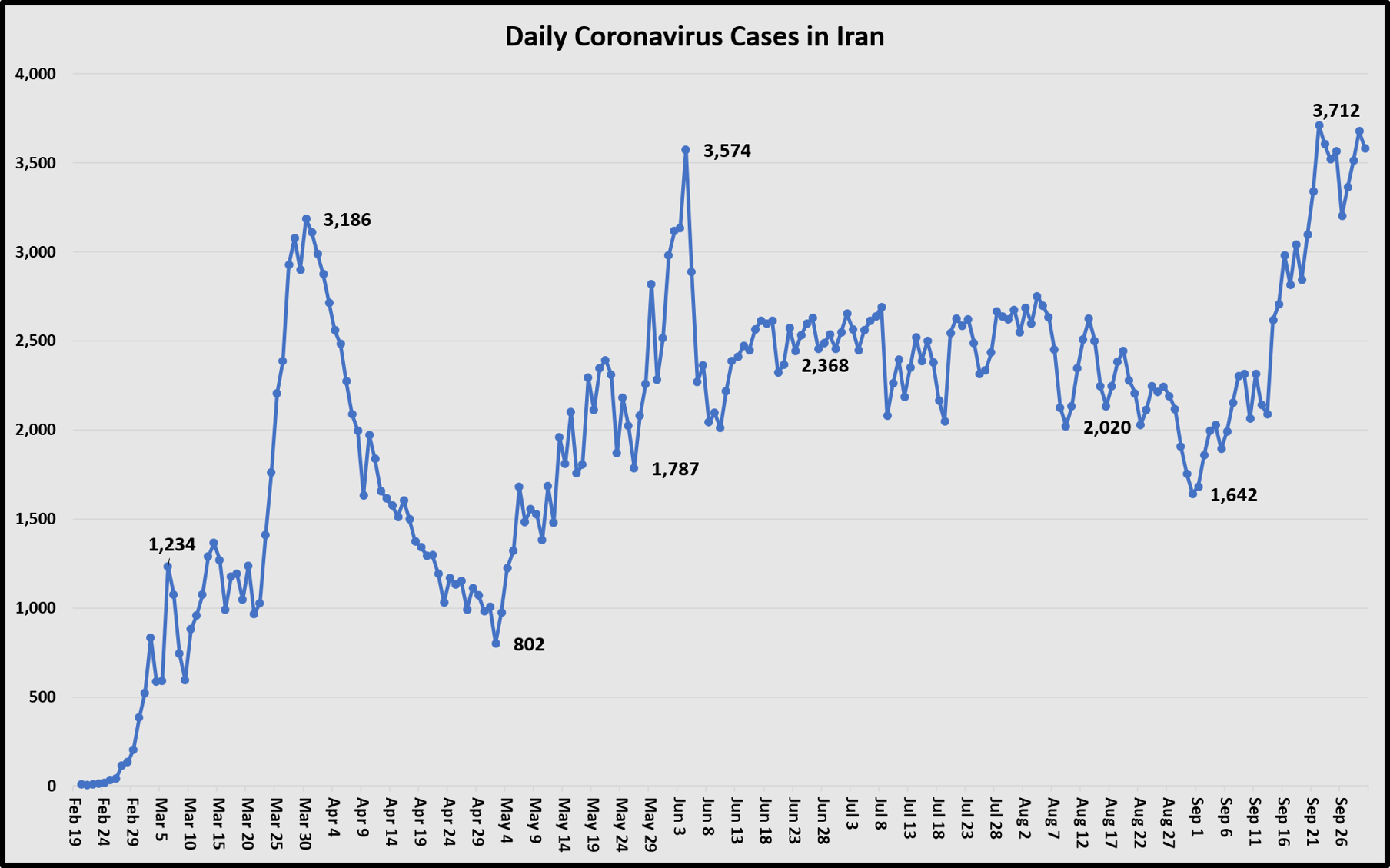
On September 7, Education Minister Mohsen Haji Mirzaei stipulated that students were “not obliged” to attend in-person classes after heavy criticism from health experts. “From the beginning, we said that students' presence at schools is not mandatory,” Mirzaei said. “We said that our priority is face-to-face education, which is more appropriate for several reasons.”
Masoud Babaei, an official from the Ministry of Cooperatives, Labor, and Social Welfare, said that 850,000 Iranians had lost their jobs between February and August due to the pandemic. In the service industry, 59 percent of the workforce lost their jobs, while 31 percent of people working in the industrial sector were unemployed.
On September 11, Health Minister Namaki announced that ceremonies for Arbaeen - the Shiite religious holiday commemorating the death of Imam Hussein - would be held virtually.
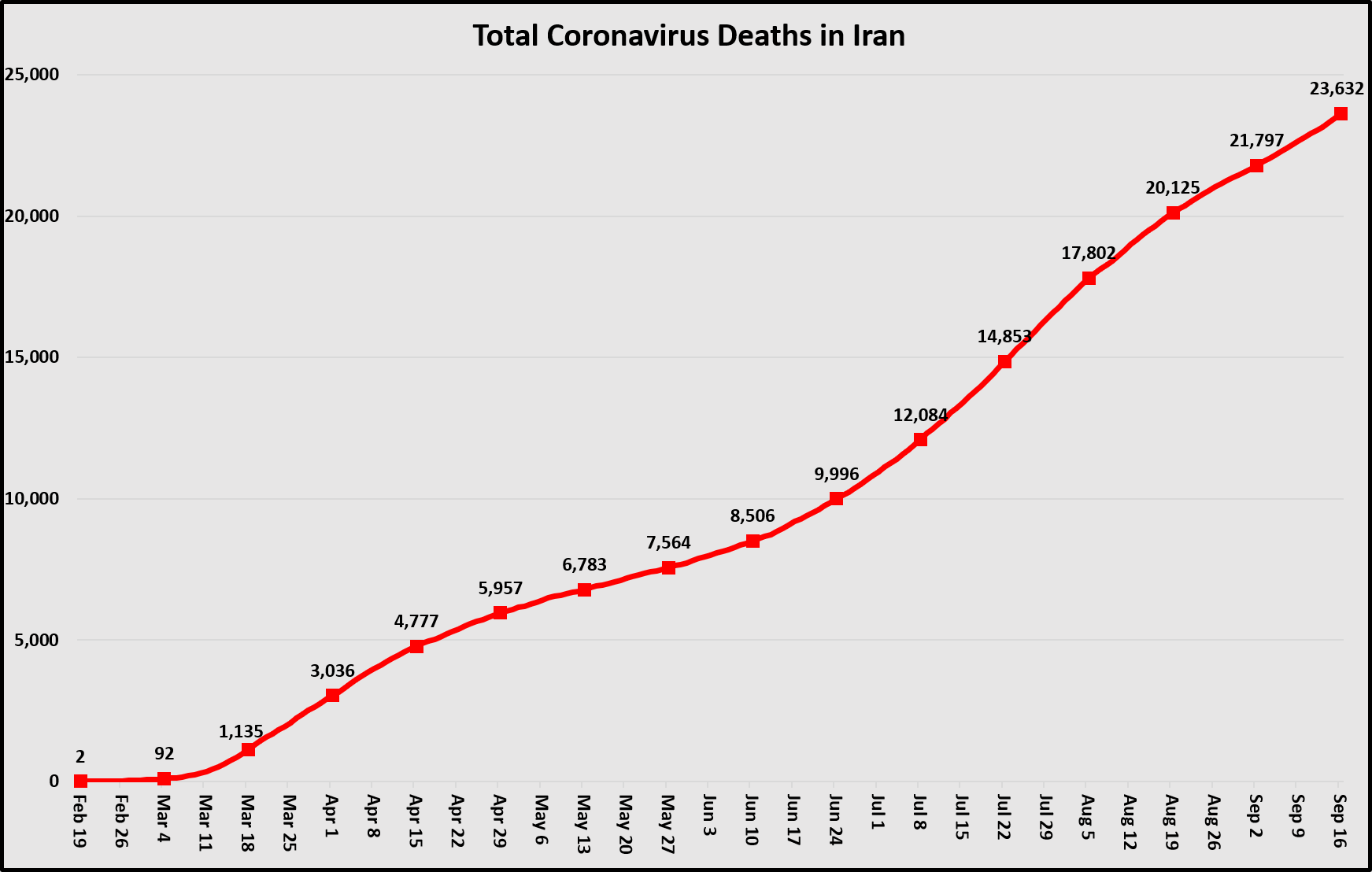
On September 12, Iran said that Tehran University would start human trials to produce a COVID-19 vaccine. Animal trials were complete and preparations were being made for clinical trials, Agricultural Minister Kazem Khavazi said.
Week 31: September 13 – September 19
On September 14, Iran recorded the highest daily increase in COVID-19 fatalities since mid-August. More than 150 patients died in a single day; the overall official death toll stood at 23,313.
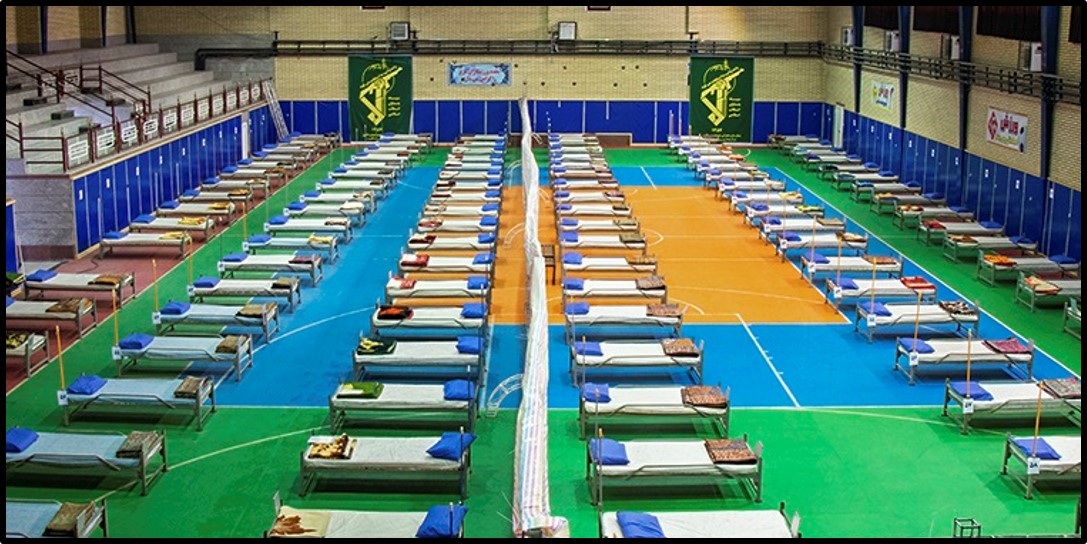
On September 17, Rouhani pledged to add 10,000 beds to hospitals across the country before March 2021. The beds would distributed to hospitals to seven provinces — in Tehran, East Azerbaijan, Esfahan, Sistan and Baluchestan, Kurdistan, Mazandaran and Gilan.
On September 18, Iran's health ministry issued a coronavirus red alert for the entire country because of a new spike in cases. “We no longer have orange and yellow,” Deputy Health Minister Harirchi said. “The entire country is red.” Harirchi warned that the death toll could reach 45,000 if the fatality rate did not decrease.
On September 18, the Tehran Stock Exchange experienced growth for the first time in five consecutive weeks.
On September 19, Iran’s health minister said that Tehran would purchase 20 million doses of a coronavirus vaccine from an Indian company. Iran had negotiated a “lower and more reasonable price” for the vaccine, he claimed.
Week 32: September 20 – September 26
On September 20, the banking sector loaned more than $1 billion to private sector businesses impacted by the coronavirus over a six-week period, the governor of Iran’s Central Bank said.
On September 22, the health ministry reported an all-time high in new infections. More than 3,700 new cases were identified in one day, which was the highest daily increase since the pandemic was first tracked in February.
On September 22, Iran cancelled public processions for the Shiite holiday of Arbaeen. The government discouraged Iranians from traveling to the holy city of Karbala for the pilgrimage. In turn, Iraq said that no Iranian pilgrims would be allowed to cross the border.
On September 23, President Rouhani blasted the United States for maintaining sanctions on Iran during COVID-19 pandemic. “My nation, the resilient people of Iran, instead of enjoying global partnership and cooperation, is grappling with the harshest sanctions in history,” he told a virtual meeting of the U.N. General Assembly.
#COVID19 is a common pain, demonstrating that our ignorance outweighs our knowledge
— Hassan Rouhani (@HassanRouhani) September 22, 2020
It reminds us of imperative of humility &humbleness, that global issues need global participation
Iranians are grappling w/ harshest sanctions in history imposed in blatant violation of UN Charter
On September 24, the official death toll from the novel coronavirus was more than 25,000, the health ministry reported.
On September 25, Iran and Russia discussed jointly developing a COVID-19 vaccine. “Iran has great potential to produce the vaccine,” said Kazem Jalali, the Iranian ambassador to Moscow.
On September 26, Rouhani authorized provincial lockdowns to stem a surge in COVID-19 cases. Governors were empowered to implement one-week lockdowns of schools, universities, mosques, cafeterias and other public places.
Week 33: September 27 – October 3
On September 29, Iran announced that coronavirus infections exceeded 450,000. The death toll reached almost 26,000.
On September 30, Rouhani praised the establishment of a joint Iranian-Danish medical and pharmaceutical center in Tehran. International cooperation during the pandemic is a " very important," he said.
On October 1, Iran was ready to work with China on joint production of a coronavirus vaccine, Rouhani said.
On October 3, Iran closed schools, libraries and mosques in Tehran for a week to control the spread of the novel coronavirus. President Rouhani said that the government would fine those who violated health protocols.
Week 34: October 4 – October 10
On October 5, Iran reported 3,902 cases of COVID-19—a new daily record—and 235 deaths.
On October 6, Deputy Health Minister Harirchi announced that all Iranians would be required to wear masks in public as of October 10. The government discussed how much to fine citizens who broke heath protocols. All flights to Turkey were suspended until November 1, the civil aviation authority announced.
On October 7, the daily death toll hit an all-time high at 239, the health ministry reported.
The US regime w/
— Iran Foreign Ministry 🇮🇷 (@IRIMFA_EN) October 7, 2020
- highest num of Covid19 cases & deaths;
- a superspreader at its head;
- a record of denial of the disease;
- & continued mismanagement of its impact,
has no standing to lecture others.
As long as sanctions r in place, your hypocritical offers sound hollow. https://t.co/hiZunDAcDM
On October 9, Iran stopped admitting non-emergency patients to hospitals due to the surge in coronavirus patients, the health ministry said. All military medical units were mobilized to set up field hospitals and mobilize support for hospitals, Rear Admiral Habibollah Sayyari said.
On October 10, Face masks became mandatory in Tehran. Violators faced fines of 500,000 rials. President Rouhani allocated $100 million to purchase rapid coronavirus test kits. He spoke with Russian President Vladimir Putin on jointly developing a COVID-19 vaccine.
Week 35: October 11 – October 17
On October 12, daily deaths from COVID-19 reached a record high of 272. Vaccine trials on human subjects would begin within weeks, the health ministry said.
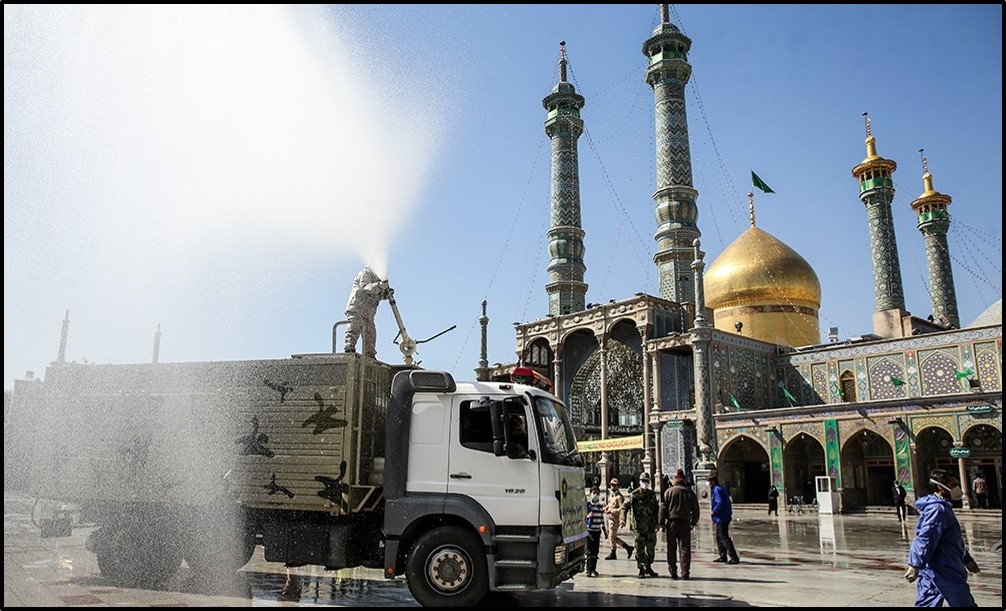
On October 13, Iran resumed gas exports to Iraqi Kurdistan. Iran and Mali cancelled a soccer match in Antalya, Turkey after several Malian players tested positive for the coronavirus. IRGC medical facilities and personnel were focused on fighting the coronavirus, Revolutionary Guards commander Hossein Salami said.
On October 14, Iran imposed a three-day travel ban on five cities: Tehran, Karaj, Mashhad, Isfahan and Orumiyeh. The ban would run from October 17 to 19 after the daily death toll rose to 279 and broke the record for the third time in a week.
On October 16, Iran Air announced an emergency return flight home for any Iranian residing in Rome after Italy recorded more than 5,000 new cases on October 9. The flight was scheduled for October 26.
On October 17, the government extended its shutdown of Tehran for a third week. Schools, mosques, restaurant and businesses remained closed until at least October 23. Iran's conventional armed forces prepared to make all military hospitals and medical centers available to coronavirus patients.
Week 36: October 18 – October 24
On October 18, The World Health Organization delivered 150 ventilators to Iran. It also donated 100 PCR machines used for testing positive cases of COVID-19.
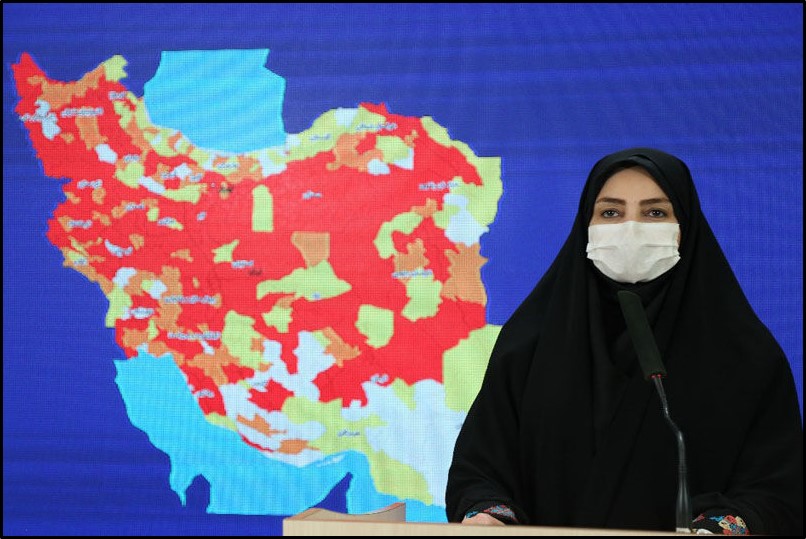
On October 19, Iran shattered its single day record with 337 deaths.
On October 20, Iran broke its single day record for daily COVID-19 cases, with 5,039 new infections.
On October 21, Iran broke its daily record for new COVID-19 cases for the second consecutive day, with 5,616 new infections.
On October 22, the Central Bank urged the International Monetary Fund (IMF) to grant Iran emergency loans to fight the pandemic. Iran had not asked the IMF for a loan since the 1960s.Tehran first requested a $5 billion loan in March, but the Trump administration blocked the funds.
On October 23, Iran reported 6,134 new coronavirus cases, another record high.
On October 24, Supreme Leader Khamenei recommended banning "unnecessary travel between cities" and "imposing strict regulations" on public transportation and public spaces.
Week 37: October 25 – October 31
On October 26, one person was dying every four minutes from COVID-19, state television reported. Partial lockdown measures went into effect in 43 cities. Nearly all private businesses, religious institutions and government buildings were told to remain closed until November 20. Half of all public sector employees were told to work remotely.
Corona's proven deadly, vicious & brutal everywhere, but it's worse in Iran as it has a cruel collaborator: US regime.
— Iran Foreign Ministry 🇮🇷 (@IRIMFA_EN) October 26, 2020
U.S. has elevated max pressure to Health Terrorism & targeted Iranian ppl w/ inhuman sanx while they're fighting the pandemic.
We'll overcome but NEVER forget. pic.twitter.com/n3c9QuIfQ7
On October 27, daily deaths reached a new record of 346, the Health Ministry reported. President Rouhani appointed his interior minister, Dr. Rahmani Fazli, to head a new COVID-19 operational center. The actual death toll might be three or four times the official tally, a senior member of Iran's medical professional organization said.
On October 28, the daily death toll exceeded 400 for the first time. One person was dying every three minutes from COVID-19, state television reported. Parliament Speaker Mohammad Baqer Qalibaf tested positive for the coronavirus, he announced on Twitter.
On October 29, new coronavirus daily cases reached an all-time high of 8,293.
On October 30, Iran exceeded 600,000 total confirmed coronavirus cases.
On October 31, the government indefinitely banned all weddings, wakes and conferences in Tehran. It also extended the lockdown of all public areas by one week.
Week 38: November 1 – November 7
On November 1, the head of Iran's Medical Council, Mohammadreza Zafarghandi, said that true death toll was "at least three times higher than the official death toll." The Council reached its figure through field surveys in hospitals and cemeteries.
On November 2, the government imposed a four-day travel ban on 25 cities. The daily death toll reached 440, another record high.
On November 3, new daily coronavirus cases hit 8,932, another record high.
On November 4, banks and tourism businesses hurt by the pandemic began receiving government loans.
On November 7, President Rouhani called for "strict observance" of health protocols. “Dealing with the coronavirus outbreak is an easy issue if health protocols are followed, but if members of the society ignore health protocols and become ill, it will be a difficult issue for the entire country," he said.
— IranGov.ir (@Iran_GOV) November 8, 2020
Week 39: November 8 – November 14
On November 9, Iran surpassed 10,000 new daily coronavirus cases. The government approved four herbal medicines for treating coronavirus symptoms. "None of these drugs are a cure for COVID-19, but they have effects to reduce the symptoms of this disease," said Kianoush Jahanpour, the spokesperson for Iran’s Food and Drug Administration.
On November 10, the government imposed a month-long nightly curfew starting at 6 p.m. on restaurants and nonessential businesses in Tehran and other large cities. More than 100,000 coronavirus tests would be carried out per day, the health ministry said.
On November 11, Iran's daily death toll reached 462, another record high.
On November 13, Tehran was considering a two-week total lockdown of the capital that would include all non-essential businesses, Iranian media reported.
On November 14, the government began human clinical trials for two potential coronavirus vaccines.
Week 40: November 15 – November 21
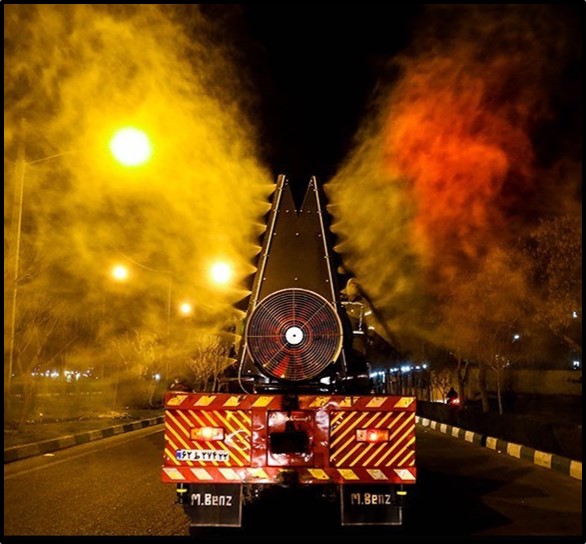
On November 15, President Rouhani announced that Iran would impose a "comprehensive lockdown" starting on November 21. Non-essential businesses would be closed and cars would not be permitted to enter or leave 100 cities. "The government has no choice but to impose new policies and restrictions at the suggestion of experts and prevent the spread of the destructive virus," he said.
On November 16, Iran's COVID-19 outbreak broke another record high, with 13,053 new infections and 486 death in a single day.
On November 17, President Rouhani pledged economic relief to businesses hurt by the lockdown measures in next year's budget, which would be submitted to parliament by December 5.
On November 18, Iran recorded another all-time high, with 13,421 new cases. More than 800,000 people had been infected since February.
On November 21, lockdowns for non-essential businesses and travel bans between major cities went into effect. Streets in Tehran remained "crowded despite the restrictions," state TV reported.
Week 41: November 22 – November 28
On November 24, the government threatened businesses that violated lockdown with fines ranging from 3 million rials ($11.50) to 15 million rials ($57.80). New cases hit another record high, with 13,721 infections within 24 hours.
On November 26, the health ministry confirmed that Iranian scientists would cooperate with Russian companies to develop a vaccine.
On November 27, daily coronavirus cases exceeded 14,000 for the first time, another all-time high.
Week 42: November 29 – December 5
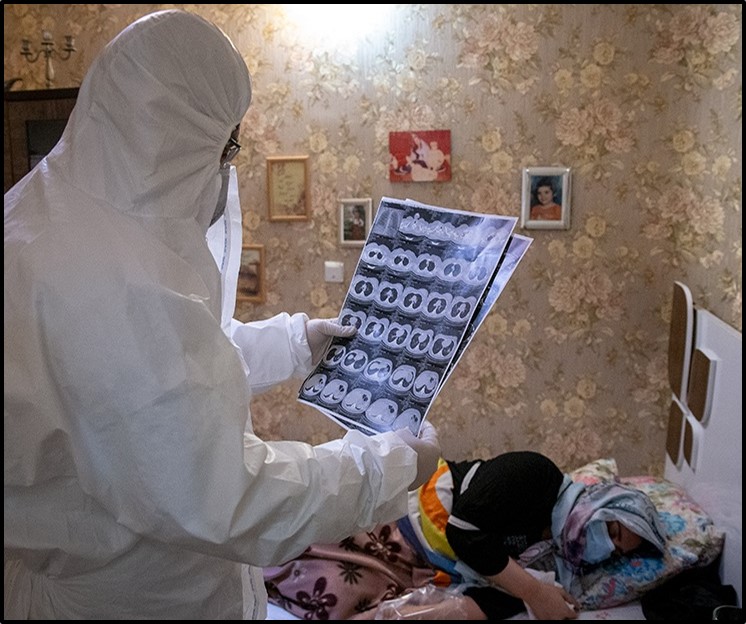
On December 1, President Rouhani pledged to support the "underprivileged" and those hit hardest by the pandemic in 2021 budget bill.
On December 2, the government said businesses in Tehran would be permitted to reopen on December 5 after a two-week lockdown. Iran would begin domestic production of a coronavirus vaccine in the spring, Health Minister Namaki said.
On December 3, Iran's total COVID-19 cases since February exceeded one million.
On December 4, the government extended lockdowns across major cities for another two weeks.
On December 5, the government unveiled a new relief package for businesses impacted by COVID-19. The measures included tax relief and postponing bank and insurance payments.
Week 43: December 6 – December 12
On December 7, the Central Bank governor claimed that U.S. financial sanctions were blocking purchase of the coronavirus vaccine by Iran.

On December 9, the government would both import and produce domestically the COVID-19 vaccine in the coming months, President Rouhani said. He claimed that U.S. financial sanctions were blocking Iran's ability to importing medicines, vaccines and medical equipment.
On December 12, deaths from coronavirus infections were down significantly, Health Minister Namaki said. "We will have a much brighter prospect in tackling the pandemic,” he told reporters.
Week 44: December 13 – December 19
On December 13, the number of cities on red alert dropped from 160 to 23, the health ministry said. The number of new infections dropped to the lowest since October.
On December 14, Iran would distribute its homegrown COVID-19 vaccine early next summer, the health ministry said.
On December 15, COVID-19 deaths in Tehran province had dropped significantly due to health protocols and lockdown measures, the provincial governor said. “Although we have not reached stable circumstances, the disease is being better managed compared to last month,” Governor Anoushiravan Mohseni-Bandpey said. He warned that easing restrictions prematurely could trigger a new rise in infections.
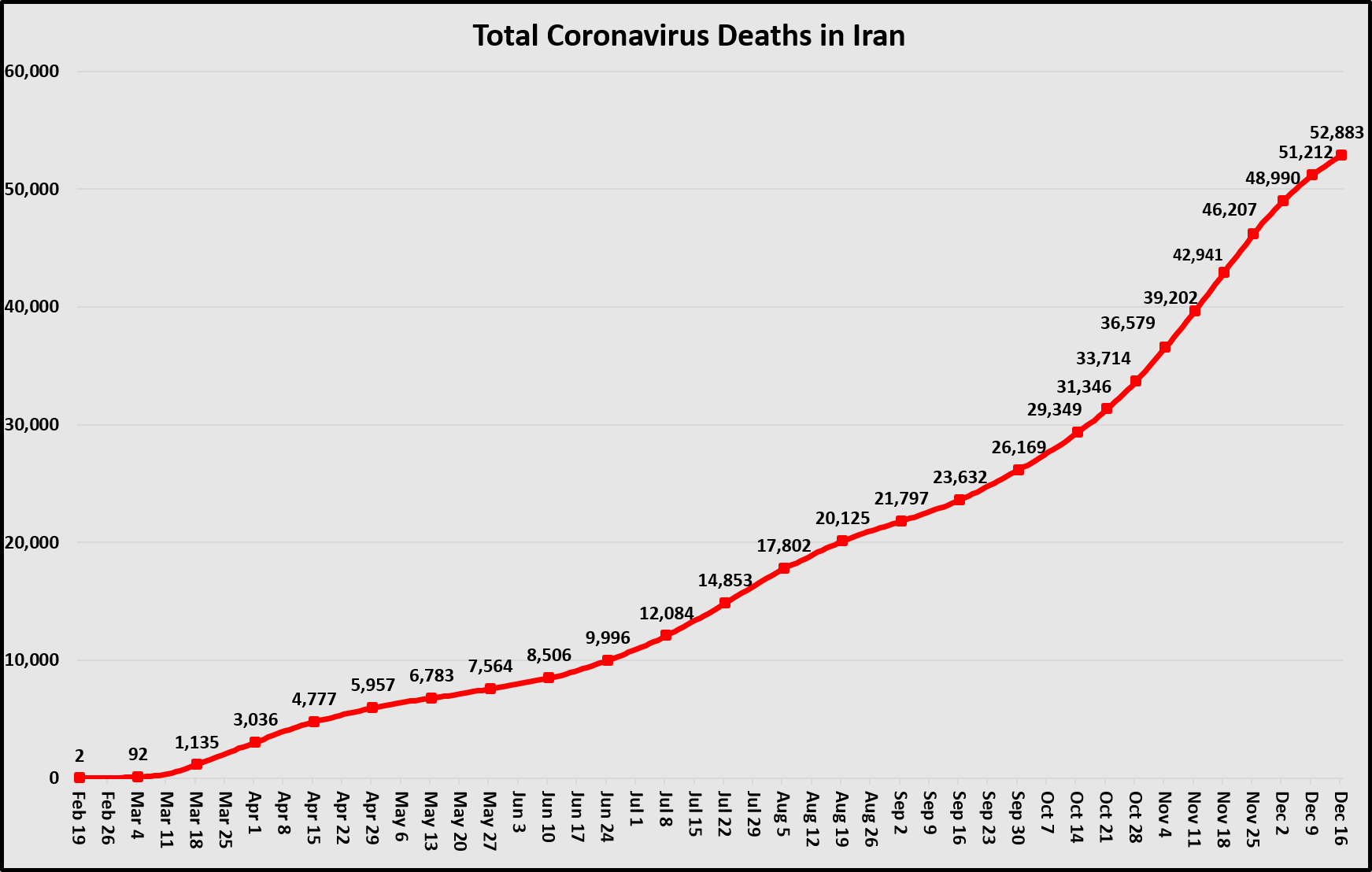
On December 16, Iran would issue permits to produce Remdesivir, an anti-viral drug effective in COVID-19 treatment, Health Minister Namaki said.
